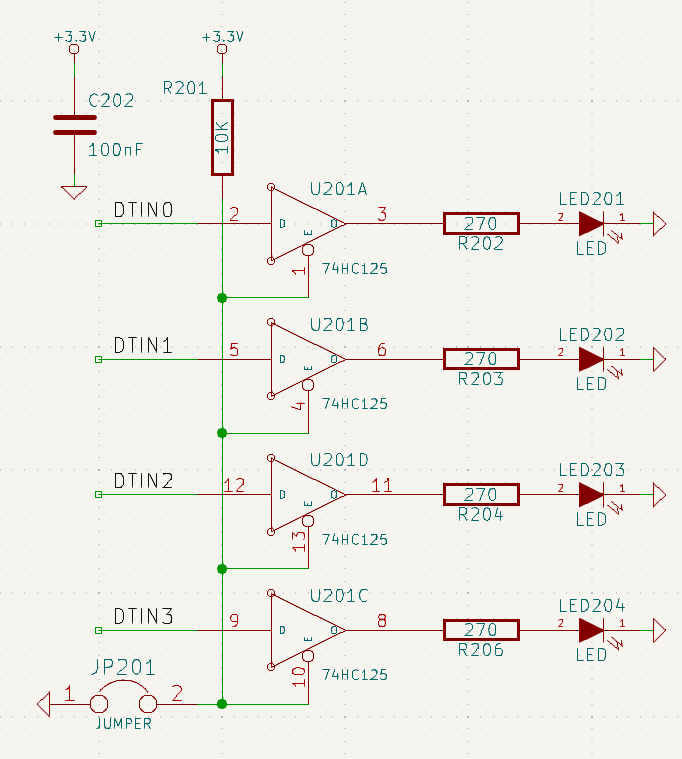
Copyright
Questo documento è coperto dal Copyright © 2010-2024 dei suoi autori come elencati in seguito. È possibile distribuirlo e/o modificarlo nei termini sia della GNU General Public License (http://www.gnu.org/licenses/gpl.html), versione 3 o successive, che della Creative Commons Attribution License (http://creativecommons.org/licenses/by/3.0/), versione 3.0 o successive.
Tutti i marchi registrati all’interno di questa guida appartengono ai loro legittimi proprietari.
Contributors
Graham Keeth, Jon Evans, Glenn Peterson.
Former Contributors
David Jahshan, Phil Hutchinson, Fabrizio Tappero, Christina Jarron, Melroy van den Berg.
Feedback
Il progetto KiCad accoglie commenti, segnalazioni di difetti e suggerimenti relativi al software o alla sua documentazione. Per ulteriori informazioni su come inviare commenti o segnalare un problema, consultare le istruzioni su https://www.kicad.org/help/report-an-issue/
Software and Documentation Version
Questo manuale utente è basato su KiCad 9.99. Funzionalità e aspetto potrebbero variare in altre versioni di KiCad.
Revisione documentazione: f0f53076.
Introduzione a KiCad versione Nightly
KiCad è una suite software open source per la creazione di schemi di circuiti elettrici, circuiti stampati (PCB) e descrizioni delle parti associate. KiCad supporta flussi di lavoro di progettazione integrati in cui uno schema e un C.S, corrispondenti vengono progettati assieme, ma anche flussi di lavoro indipendenti per usi speciali. KiCad include anche diverse utilità per aiutare nella progettazione di schemi e C.S., tra cui una calcolatrice di C.S. per determinare le proprietà elettriche delle strutture dei circuiti, un visualizzatore file Gerber per l’ispezione dei file di produzione, un visualizzatore 3D per visualizzare la scheda finita e un simulatore SPICE integrato per il controllo del comportamento circuitale.
KiCad funziona su tutti i principali sistemi operativi e su un’ampia gamma di computer. Supporta circuiti stampati con un massimo di 32 strati rame ed è adatto a creare progetti di ogni tipo di complessità. KiCad viene sviluppato da un team di programmatori e progettisti elettronici volontari provenienti da tutto il mondo con la missione di creare un programma di progettazione elettronica (CAD) gratuito e libero per la progettazione professionale.
La documentazione più aggiornata di KiCad è disponibile su https://docs.kicad.org. Questo documento si riferisce a KiCad versione 9.0.
Scaricamento e installazione di KiCad
KiCad funziona su molti sistemi operativi, inclusi Microsoft Windows, Apple macOS e molte delle principali distribuzioni Linux.
Si possono trovare istruzioni aggiornate e collegamenti per il download all’indirizzo https://www.kicad.org/download/. Queste istruzioni non sono incluse in questo manuale in quanto possono cambiare nel tempo e con il rilascio degli aggiornamenti del sistema operativo.
Se si riscontrano problemi durante l’esecuzione di KiCad sul proprio sistema, controllare l’elenco dei problemi noti relativi al sistema e alle relative soluzioni alternative su https://www.kicad.org/help/known-system-related-issues/.
| I rilasci stabili di KiCad avvengono periodicamente secondo la https://dev-docs.kicad.org/" "en/rules-guidelines/release-policy/[Politica dei rilasci stabili di KiCad]. Nuove funzioni vengono aggiunte continuamente al ramo di sviluppo. Se si vuole sfruttare queste nuove caratteristiche e contemporaneamente aiutare a testarne lo sviluppo, scaricare l’ultimo pacchetto "nightly build" ovvero sperimentale, per la propria piattaforma. I pacchetti sperimentali possono presentare dei bachi tuttavia è l’obiettivo del team di sviluppo di KiCad mantenere il ramo di sviluppo più utilizzabile possibile anche durante lo sviluppo di nuove funzionalità. |
Supporto
Se avete idee, commenti o domande o se vi serve solamente un aiuto:
-
Il forum ufficiale degli utenti KiCad è un ottimo sito per entrare in contatto con altri utenti KiCad ed ottenere aiuto.
-
Unisciti alle nostre comunità su Discord o IRC per discutere in tempo reale con utenti e sviluppatori.
-
Esplora le risorse didattiche presenti sul sito di KiCad create dalla comunità.
Concetti di base e diagramma di flusso
Il flusso di lavoro tipico di KiCad consiste in due compiti principali: disegno di uno schema elettrico e progettazione di un circuito stampato.
Lo schema elettrico è una rappresentazione simbolica del circuito: esso indica che componenti vengono impiegati e quali sono le connessioni che vengono effettuate tra di essi. I simboli nello schema sono rappresentazioni grafiche dei componenti elettronici presenti in esso, come lo zigzag per una resistenza o un triangolo per un amplificatore operazionale. Lo schema contiene i simboli per ogni componente del progetto, con i fili che collegano i piedini nei simboli. In genere lo schema elettrico viene creato per primo, in seguito si dispone i componenti nel circuito stampato.

La scheda è la realizzazione fisica dello schema, con le impronte dei componenti posizionate sulla scheda e le tracce in rame che realizzano le connessioni descritte nello schema. Le impronte sono un insieme di aree di rame che corrispondono ai pin su un componente fisico. Quando la scheda viene prodotta e assemblata, il componente verrà saldato sulla sua impronta corrispondente sul circuito stampato.
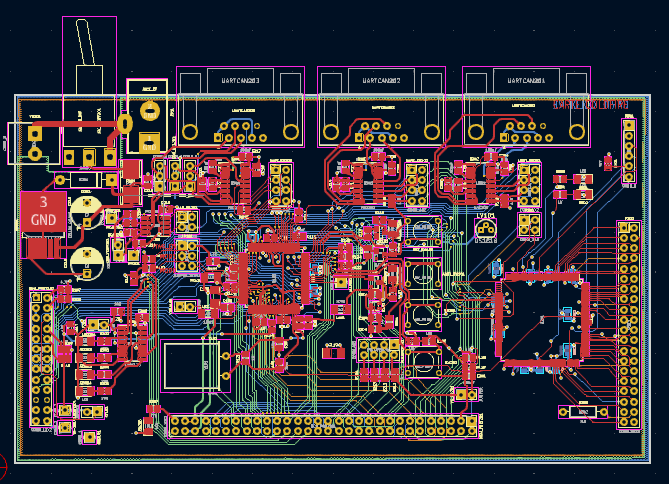
KiCad ha finestre separate per disegnare lo schema ("Editor dello schema"), disporre la scheda ("Editor del Circuito Stampato") e modificare simboli e impronte ("Editor dei simboli" e "Editor delle impronte"). KiCad viene fornito con un’ampia libreria di simboli e impronte di alta qualità forniti all’utente, ma è anche semplice creare nuovi simboli e impronte o modificare simboli e impronte esistenti.
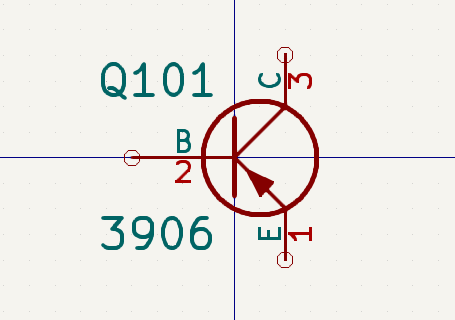
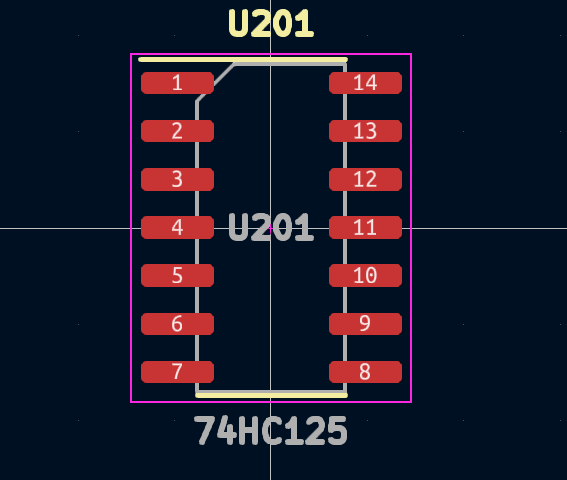
Infine, è importante capire che KiCad ha un flusso di lavoro basato sul progetto. Un progetto KiCad è una cartella con un file di progetto, uno schema, un layout o disposizione del circuito stampato e, facoltativamente, altri file associati come librerie di simboli e impronte, dati di simulazione, distinta di base dei componenti, ecc. Molte impostazioni relative al progetto, comprese le netclass e le regole di progettazione, vengono memorizzate a livello di progetto. L’apertura di una scheda al di fuori del progetto associato può comportare la mancanza di informazioni di progettazione, quindi è meglio assicurarsi di mantenere assieme tutti i file associati ad uno specifico progetto.
Il flusso di progettazione di C.S.
In genere, lo schema elettrico viene disegnato per primo. Ciò significa aggiungere simboli allo schema e tracciare le connessioni tra di loro. Potrebbe essere necessario creare simboli personalizzati se i simboli appropriati non sono già disponibili. In questa fase vengono anche selezionate le impronte per ogni componente, con impronte personalizzate create secondo necessità. Quando lo schema è completo e il progetto ha superato un controllo delle regole elettriche (ERC), le informazioni sul progetto nello schema vengono trasferite all’editor del circuito stampato e inizia la fase di layout.
Lo schema descrive quali componenti sono presenti nel progetto e come sono collegati; l’editor del circuito stampato usa queste informazioni per semplificare la disposizione e prevenire discrepanze tra lo schema e il circuito stampato. Il processo di layout richiede il posizionamento accurato di ciascuna impronta sul circuito stampato. Dopo il posizionamento dei componenti, le tracce di rame vengono tracciate tra i componenti in base alle connessioni nello schema e ad altre considerazioni elettriche, come resistenza di traccia, requisiti di impedenza controllata, diafonia, ecc.
Spesso lo schema dovrà essere aggiornato dopo l’inizio della disposizione; le modifiche allo schema possono essere facilmente riflesse nel progetto dello stampato. Spesso può accadere il contrario: qualsiasi modifica progettuale apportata al layout fisico della scheda può essere rimandata indietro allo schema per mantenere le due coerenti uno con l’altro.
Quando il layout della scheda è completo e la scheda ha superato il controllo regole elettriche (DRC), vengono generati i file necessari per la fabbricazione in modo che la scheda possa essere prodotta dal fabbricante di circuiti stampati.
Tutorial parte 1: il progetto
La prima cosa da fare quando si inizia è creare un nuovo progetto. Aprendo KiCad si aprirà la finestra del progetto. Fare clic su File → Nuovo progetto, individuare la posizione desiderata e assegnare un nome al progetto, ad esempio per-iniziare. Assicurati che la casella di controllo Crea una nuova cartella per il progetto sia selezionata, quindi fare clic su Salva. Questo creerà tuoi file di progetto in una nuova sottocartella con lo stesso nome del progetto.
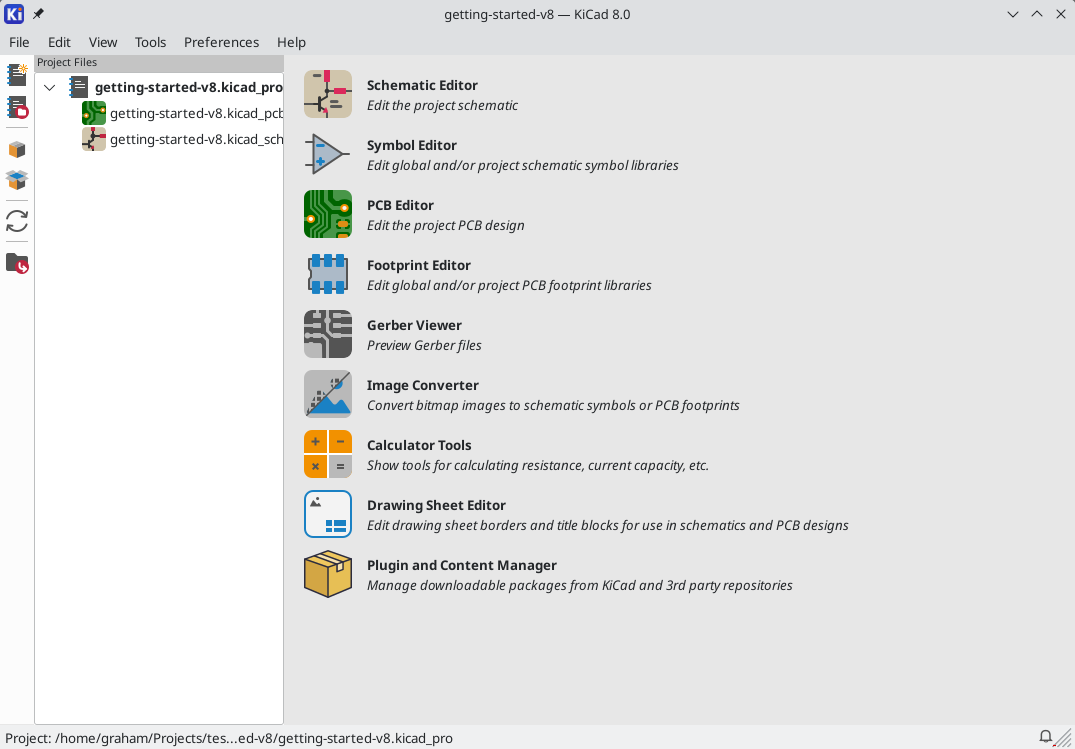
A sinistra, il riquadro File progetto elenca i file nel nuovo progetto. C’è un file progetto con estensione .kicad_pro, un file schema con estensione .kicad_sch e un file circuito stampato con estensione .kicad_pcb. Questi file condividono tutti lo stesso nome del progetto.
Potrebbe esserci anche una cartella -backups: KiCad creerà automaticamente il backup del progetto quando si salva, e opzionalmente, a intervalli di tempo fissi. Le impostazioni di backup sono configurabili andando su Preferenze → Preferenze… → Comuni → Backup progetto.
| L’apertura della finestra delle preferenze può far aprire la configurazione della tabella delle librerie. Questa è descritta di seguito. |
| Su macOS, la finestra delle preferenze è nel menu KiCad, non nel menu delle Preferenze. |
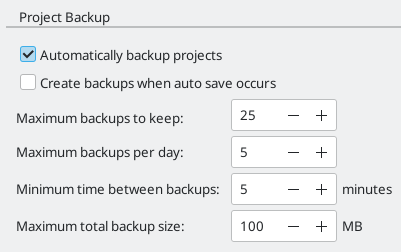
A destra della finestra del progetto, ci sono dei pulsanti per avviare i vari strumenti forniti da KiCad. L’avvio di questi strumenti aprirà automaticamente il file di progettazione associato (dello schema o del C.S.) dal progetto corrente. Iniziare aprendo l’editor degli schemi elettrici.
Tutorial parte 2: schemi elettrici
Impostazione tabella librerie dei simboli
La prima volta che si apre l’editor degli schemi, viene visualizzata una finestra di dialogo che chiede come configurare la tabella della libreria dei simboli globale. La tabella delle librerie di simboli indica a KiCad quali librerie di simboli utilizzare e dove si trovano. Se si ha installato le librerie predefinite con KiCad, cosa consigliata, selezionare l’opzione predefinita: Copia la tabella librerie simbolo globale predefinita (raccomandato).
Se KiCad non riesce a trovare le librerie nella posizione di installazione prevista, questa opzione verrà disabilitata. In tal caso, si dovrebbe scegliere la seconda opzione, *Copia la tabella librerie simbolo globale personalizzata. Fare clic sul pulsante cartella in fondo, ed esplorare la cartella del percorso data. Selezionare il file sym-lib-table.
La posizione dei file tabella librerie predefinite dipende dal sistema operativo e può variare in base alla posizione di installazione. In basso le posizioni predefinite per ogni sistema operativo:
-
Windows:
C:\Program Files\KiCad\9.0\share\kicad\template\ -
Linux:
/usr/share/kicad/template/ -
macOS:
/Applications/KiCad/KiCad.app/Contents/SharedSupport/template/
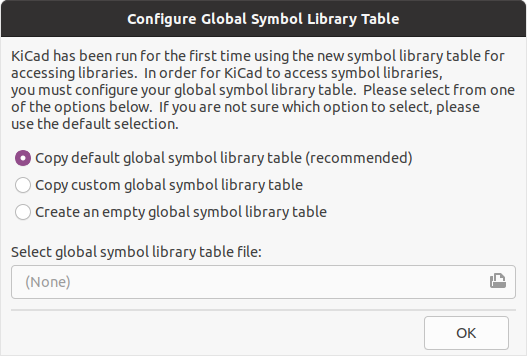
Basi dell’editor degli schemi elettrici
Per fare pan in giro per lo schema, fare clic e trascinare con il pulsante centrale o quello destro del mouse. Ingrandire e rimpicciolire con la rotellina or F1 e F2. Gli utenti dei portatili potrebbero trovare comodo cambiare i controlli del mouse per accordarli meglio con il touchpad; i controlli del mouse sono configurabili in Preferenze → Preferenze… → Mouse e Touchpad.
| Su macOS, la finestra delle preferenze è nel menu KiCad, non nel menu delle Preferenze. |
Per impostazione predefinita, KiCad abilita un’impostazione del mouse denominata Centra e sposta il puntatore con lo zoom. Quando questa funzione è abilitata, il cursore del mouse si sposta automaticamente al centro dello schermo quando l’utente esegue lo zoom avanti o indietro. Ciò mantiene la regione ingrandita sempre centrata. Questa funzione può sembrare un po' strana all’inizio, ma molti utenti la trovano utile una volta abituati. Provare a ingrandire e rimpicciolire con il puntatore del mouse in diverse aree dell’area di lavoro. Se il comportamento dello zoom predefinito risulta scomodo, disabilitare la funzione nelle preferenze Mouse e Touchpad.
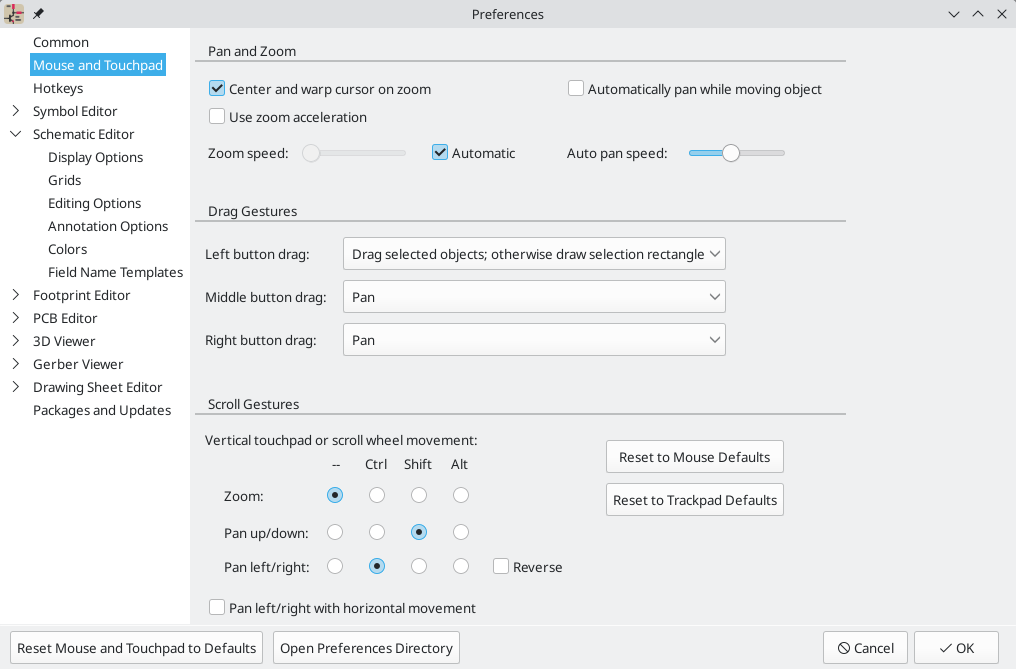
La barra degli strumenti sul lato sinistro dell’editor degli schemi contiene le impostazioni di visualizzazione di base. La barra degli strumenti sul lato destro dello schermo contiene gli strumenti per modificare lo schema.
Alla maggior parte degli strumenti in KiCad sono assegnati comandi da tastiera predefiniti o possono essere assegnati comandi da tastiera personalizzati. Per visualizzare tutti i comandi da tastiera, andare su Aiuto → Elenco tasti…. I comandi da tastiera possono essere modificati nel pannello Comandi da tastiera della finestra delle Preferenze.
Impostazione foglio schema
Prima di disegnare qualcosa nello schema, impostare il foglio dello schema stesso. Fare clic su File → Impostazioni pagina. Assegnare allo schema un titolo e una data e, se si vuole, modificare il formato della carta.
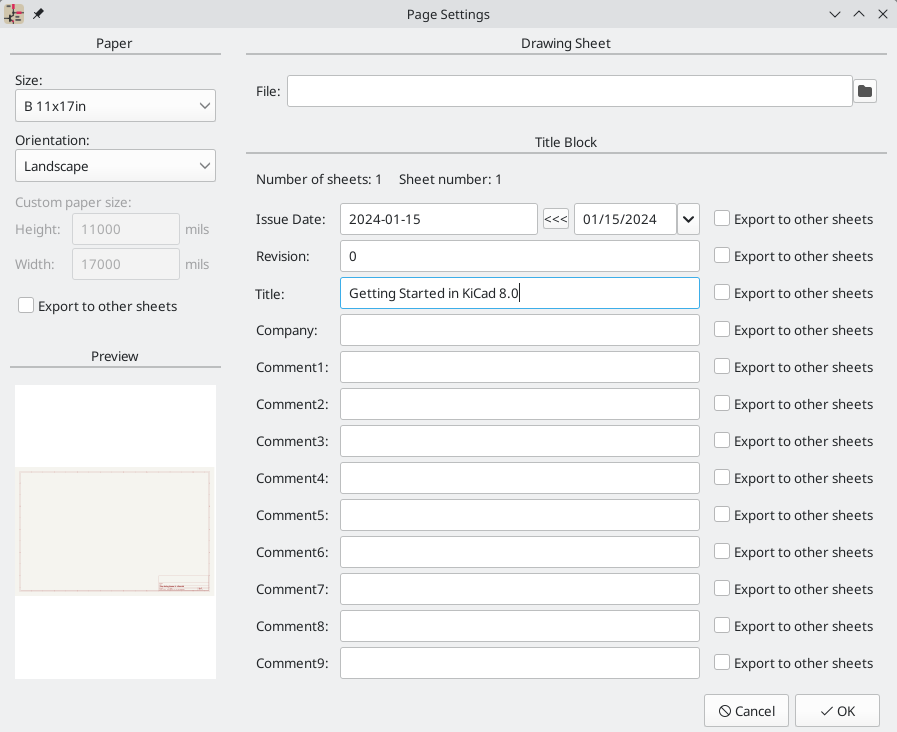
Aggiunta di simboli allo schema
Iniziare a creare il circuito aggiungendo alcuni simboli allo schema. Aprire la finestra di dialogo Scegliere simbolo facendo clic sul pulsante Aggiungi simboli  sul lato destro della finestra o premendo A.
sul lato destro della finestra o premendo A.
Questa azione attiverà la finestra di dialogo per l’impostazione della tabella librerie di impronte se questa non è già stata attivata. Questa finestra di dialogo è equivalente alla finestra di dialogo di impostazione della tabella librerie di simboli spiegata in precedenza, ma per le impronte anziché per i simboli.
Di nuovo, selezionare l’opzione predefinita: Copia la tabella librerie impronta globale predefinita (raccomandato). Se questa opzione è disabilitata, selezionare la seconda opzione, Copia tabella librerie impronta globale personalizzata. Fare clic sul pulsante cartella in basso e passare la posizione indicata le istruzioni di configurazione della tabella della libreria dei simboli. Selezionare il file fp-lib-table e fare clic su OK.
La finestra di dialogo Scegli simbolo elenca le librerie di simboli disponibili e i simboli dei componenti in esse contenuti. I dispositivi di base come componenti passivi, diodi e altri simboli generici si trovano nella libreria Device. Dispositivi specifici, come un tipo particolare di LED, si trovano nelle altre librerie.
Scorrere verso il basso fino alla libreria "Device", espanderla e selezionare il simbolo "LED". Fare clic su OK e fare nuovamente clic per posizionare il simbolo nello schema.
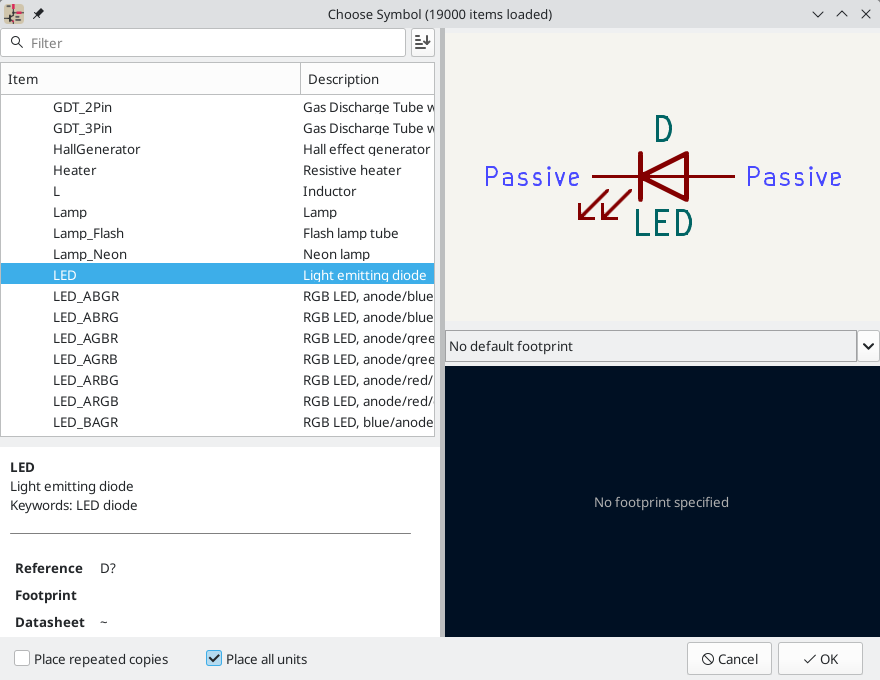
Quindi, aggiungere una resistenza di limitazione di corrente. Tornare al selettore dei simboli, ma questa volta provare a cercare una resistenza inserendo "R" nella casella del filtro in alto. Di nuovo, si trova nella libreria Device. Il dispositivo R è un simbolo di resistenza rettangolare in stile IEC. Un simbolo R_US è disponibile anche per gli utenti che preferiscono il simbolo a zigzag in stile ANSI. Selezionare un simbolo di resistenza e aggiungerlo allo schema.
Infine, aggiungere una batteria per alimentare il LED. La libreria Device ha il simbolo appropriato Battery_Cell.
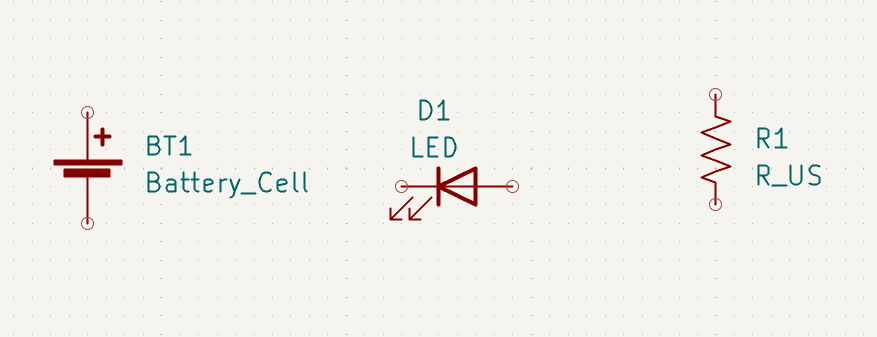
Selezione e spostamento oggetti
Poi, posizionare i simboli correttamente l’uno rispetto all’altro, come mostrato nello screenshot. A tale scopo, selezionare e poi spostare e ruotare i simboli.
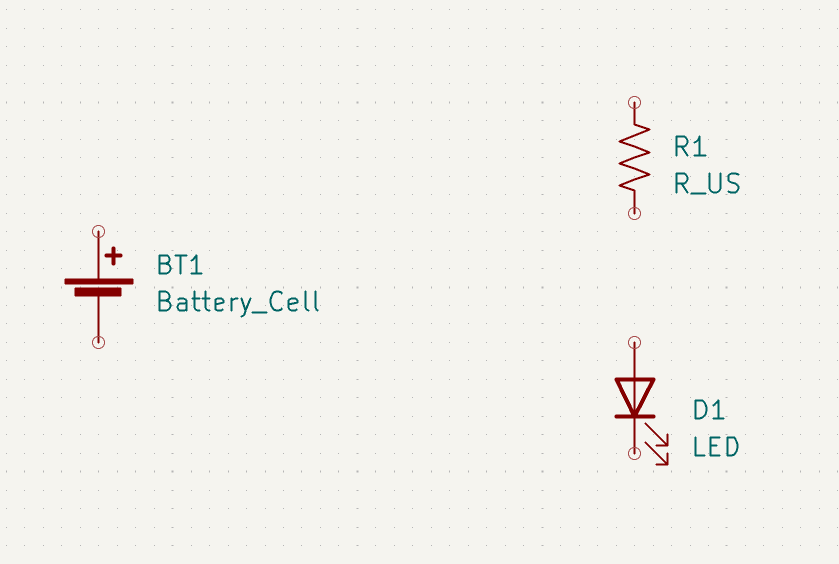
In KiCad, gli oggetti vengono selezionati facendo clic sopra di essi mentre è attivo lo strumento di selezione. Lo strumento di selezione è lo strumento predefinito quando nessun altro strumento è attivo, quindi si può entrare nello strumento di selezione chiudendo qualsiasi strumento attivo (Esc) o facendo clic sul pulsante  nella barra degli strumenti di destra.
nella barra degli strumenti di destra.
Ulteriori oggetti possono essere aggiunti alla selezione con Maiusc+clic, o rimossi con Ctrl+Maiusc+clic (MacOS: Cmd+Maiusc+clic).È possibile commutare lo stato della selezione di un oggetto con Ctrl+clic (macOS: Cmd+clic).
È anche possibile trascinare la selezione; trascinando da sinistra a destra si selezionano gli oggetti che sono interamente racchiusi dalla casella di selezione, mentre trascinando da destra a sinistra si selezionano anche gli oggetti che sono parzialmente racchiusi dalla casella di selezione. Maiusc, Ctrl+Maiusc (Cmd+Maiusc), e Ctrl (Cmd) possono essere utilizzati anche con la selezione trascinata, rispettivamente per aggiungere, sottrarre o commutare dalla selezione.
Si noti che è possibile selezionare un intero simbolo (facendo clic sulla forma del simbolo stesso) o selezionare un campo di testo nel simbolo senza selezionare il resto del simbolo (facendo clic sul testo). Quando viene selezionato solo un campo di testo, qualsiasi azione eseguita agirà solo sul testo selezionato e non sul resto del simbolo.
Gli oggetti selezionati vengono spostati premendo M e ruotati premendo R. Il tasto comando G (trascinamento) può essere utilizzato anche per spostare gli oggetti. Per lo spostamento di simboli non collegati, G e M si comportano in modo identico, ma per i simboli con fili collegati, G sposta il simbolo e mantiene i fili collegati, mentre M sposta il simbolo e lascia i fili indietro. Gli oggetti selezionati possono essere cancellati con il tasto Canc.
Cablaggio dello schema
I pin dei simboli hanno tutti dei piccoli cerchi a indicare che non sono collegati. Risolvere disegnando fili tra i pin dei simboli come mostrato nella schermata. Fare clic sul pulsante Aggiungi un filo  sulla barra degli strumenti di destra o utilizzare il tasto comando W. Fare clic e rilasciare per iniziare a disegnare un filo e finire di disegnare il filo facendo clic sul pin di un simbolo o facendo doppio clic in un punto qualsiasi. Premendo Esc si annullerà il disegno del filo.
sulla barra degli strumenti di destra o utilizzare il tasto comando W. Fare clic e rilasciare per iniziare a disegnare un filo e finire di disegnare il filo facendo clic sul pin di un simbolo o facendo doppio clic in un punto qualsiasi. Premendo Esc si annullerà il disegno del filo.
Un altro metodo conveniente per disegnare i fili è passare con il mouse su un pin scollegato. Il cursore del mouse cambierà per indicare che è possibile tracciare un filo a partire da quella posizione. Cliccando sul pin inizierà quindi a disegnare un filo automaticamente.

Quindi, aggiungere i simboli di potenza e terra allo schema. Sebbene non siano strettamente necessari in uno schema così semplice, facilitano la comprensione di schemi di grandi dimensioni.
Nella libreria dei simboli Power sono disponibili numerosi simboli di potenza / alimentazione e terra. Tuttavia, esiste una scorciatoia per aggiungere questi simboli: fare clic sul pulsante Aggiungi un simbolo di potenza  o usare il tasto comando P. Verrà visualizzata la finestra di dialogo Scegli un simbolo, ma verranno visualizzate solo le librerie di simboli che contengono i simboli di potenza e alimentazione.
o usare il tasto comando P. Verrà visualizzata la finestra di dialogo Scegli un simbolo, ma verranno visualizzate solo le librerie di simboli che contengono i simboli di potenza e alimentazione.
Aggiungere un simbolo VCC e un simbolo GND e quindi collegarli al circuito con dei fili.
Infine, aggiungere un’etichetta al filo tra il LED e la resistenza. Anche in questo caso, questo potrebbe non essere necessario in un circuito semplice, ma è buona norma etichettare le reti importanti. Fare clic sul pulsante Aggiungi etichetta  nella barra degli strumenti a destra (L), digitare un nome per l’etichetta (
nella barra degli strumenti a destra (L), digitare un nome per l’etichetta (led) e posizionare l’etichetta nello schema in modo che il punto di attacco quadrato si sovrapponga al filo. Ruotare e allineare l’etichetta se necessario.

Si noti che le etichette e le porte di alimentazione con lo stesso nome vengono considerate collegate assieme. Un’altra porta di alimentazione GND o un cavo etichettato led in questo foglio di schema verrebbe cortocircuitato con quello esistente, anche senza fili che li collegano visivamente.
Annotazione, proprietà simbolo, e impronte
Annotazione
A ciascun simbolo occorre assegnare un riferimento univoco. Questo processo è noto anche come annotazione.
Per impostazione predefinita, i simboli vengono automaticamente annotati quando vengono aggiunti allo schema. L’annotazione automatica può essere abilitata o disabilitata utilizzando il pulsante  nella barra degli strumenti di sinistra.
nella barra degli strumenti di sinistra.
Anche se non è necessario per questa guida, i simboli possono essere annotati o riannotati manualmente utilizzando il pulsante Compila i riferimenti dei simboli nello schema ( ) nella barra degli strumenti in alto.
) nella barra degli strumenti in alto.
Proprietà del simbolo
Quindi, inserire i valori per ciascun componente. Selezionare il LED, fare clic con il pulsante destro del mouse e selezionare Proprietà… (E). Questo progetto utilizzerà un LED rosso, quindi cambiare il campo Valore in rosso. In un progetto reale, potrebbe essere meglio scrivere qui il numero di parte del produttore del LED. Si noti che è possibile modificare i riferimenti individualmente nelle proprietà di ciascun simbolo.
Questo progetto userà una batteria a bottone al litio da 3 V, quindi cambiare il campo Valore di BT1 in 3 `. Cambiare il valore della resistenza in `1k.
Assegnamento impronte
Infine, assegnare un’impronta a ciascun componente. Ciò definirà come ogni componente si collegherà al C.S.. Alcuni simboli vengono forniti con impronte preassegnate, ma per molti componenti ci sono più impronte possibili, quindi l’utente dovrà selezionare quella appropriata.
Esistono diversi modi per assegnare le impronte; un modo comodo è usare lo strumento di assegnazione impronte facendo clic sul pulsante ![]() nella barra degli strumenti in alto.
nella barra degli strumenti in alto.
Il riquadro sinistro di questa finestra elenca le librerie di impronte disponibili. Il riquadro centrale mostra i simboli nello schema. A tutti questi simboli verranno assegnate delle impronte. Il riquadro di destra mostra le impronte impostabili per il simbolo selezionato nel riquadro centrale. Per assegnare un’impronta a un simbolo, selezionare il simbolo nel riquadro centrale e fare doppio clic sull’impronta desiderata nel riquadro di destra. Si può ottenere un’anteprima dell’impronta facendo clic con il pulsante destro del mouse su un’impronta e selezionando Visualizza impronta selezionata.

Molte impronte sono incluse in KiCad, quindi lo strumento di assegnazione delle impronte offre diversi modi per filtrare le impronte che non sono rilevanti per il simbolo in questione.

-
Il pulsante più a sinistra
 attiva i filtri che possono essere definiti in ogni simbolo. Ad esempio, un simbolo opamp potrebbe definire filtri che mostrano solo impronte SOIC e DIP. A volte quei filtri predefiniti mancano o sono troppo restrittivi, quindi può essere utile disattivare questo filtro in alcune situazioni.
attiva i filtri che possono essere definiti in ogni simbolo. Ad esempio, un simbolo opamp potrebbe definire filtri che mostrano solo impronte SOIC e DIP. A volte quei filtri predefiniti mancano o sono troppo restrittivi, quindi può essere utile disattivare questo filtro in alcune situazioni. -
Il pulsante centrale
 filtra in base al conteggio dei pin, in modo che vengano mostrate solo le impronte di 8 pad per i simboli a 8 pin. Questo filtro è quasi sempre utile.
filtra in base al conteggio dei pin, in modo che vengano mostrate solo le impronte di 8 pad per i simboli a 8 pin. Questo filtro è quasi sempre utile. -
Il pulsante destro
 filtra in base alla libreria selezionata. Le librerie sono selezionate nel riquadro di sinistra; le impronte non nella libreria selezionata verranno filtrate. Questo filtro è utile purché sia noto quale libreria contiene l’impronta corretta. Spesso è meglio usare questo filtro oppure i filtri simbolo, ma non entrambi.
filtra in base alla libreria selezionata. Le librerie sono selezionate nel riquadro di sinistra; le impronte non nella libreria selezionata verranno filtrate. Questo filtro è utile purché sia noto quale libreria contiene l’impronta corretta. Spesso è meglio usare questo filtro oppure i filtri simbolo, ma non entrambi. -
La casella di testo filtra le impronte che non corrispondono al testo nella casella. Questo filtro è disabilitato quando la casella è vuota.
Usando i filtri, trovare ciascuna delle impronte mostrate nella colonna centrale della schermata qui sopra. Nella tabella sottostante sono elencate anche le impronte di ciascun simbolo. Assegnare ogni impronta a un simbolo selezionando il simbolo nella colonna centrale e quindi facendo doppio clic sull’impronta appropriata nella colonna di destra. Una volta assegnate tutte le impronte, fare clic su OK.
| Symbol Reference | Footprint to assign |
|---|---|
|
|
|
|
|
|
Ci sono altri modi per assegnare le impronte; un modo è attraverso la finestra delle proprietà del simbolo. Per ulteriori informazioni sull’assegnazione delle impronte, consultare il manuale.
Controllo regole elettriche
L’ultima cosa da fare nello schema è controllare gli errori di natura elettrica. Il controllo delle regole elettriche (ERC) di KiCad non può garantire che il progetto nello schema funzioni, ma può verificare che non sussistano banali problemi di connessione come pin scollegati, uscite di alimentazione in cortocircuito o ingressi di alimentazione non alimentati. Esso verifica anche la presenza di altri errori come simboli non annotati e errori di battitura nelle etichette delle connessioni. Per visualizzare l’elenco completo delle regole elettriche e regolarne l’importanza, andare su File→Impostazioni dello schema… → Regole elettriche → Importanza violazioni. È sempre una buona idea avviare un controllo regole elettriche prima di avviare la stesura del circuito stampato.
Eseguire un controllo delle regole elettriche facendo clic sul pulsante ERC  nella barra degli strumenti in alto e quindi facendo clic su Esegui ERC.
nella barra degli strumenti in alto e quindi facendo clic su Esegui ERC.
Anche in questo semplice schema, KiCad ha riscontrato due potenziali errori. Gli errori sono elencati nella finestra ERC e le frecce indicano le posizioni delle violazioni nello schema. Selezionando una violazione nella finestra ERC si evidenzia la freccia corrispondente.
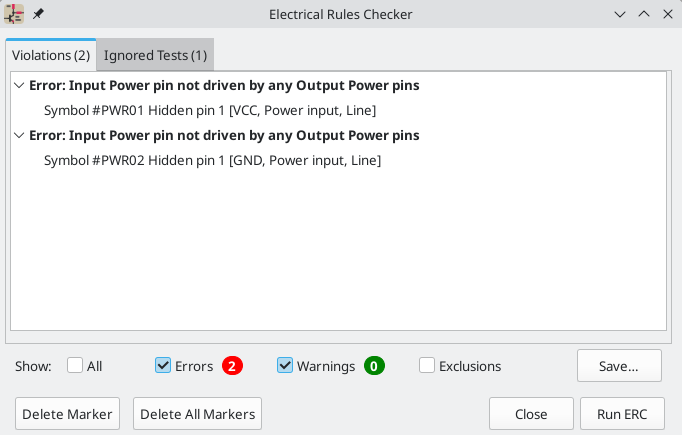
Le violazioni si possono ignorare (per l’esecuzione ERC corrente) o escludere (da tutte le future esecuzioni ERC) facendo clic con il pulsante destro del mouse su ciascun messaggio di errore. Tuttavia, di solito vale la pena affrontare le violazioni, anche se non sono veri e propri errori di progettazione, al fine di ottenere un rapporto ERC pulito ed evitare di farsi sfuggire dei problemi reali.
In questo caso, KiCad segnala "Pin di potenza in ingresso non pilotato da alcun pin di potenza in uscita" per entrambe le reti VCC e GND. Questo è un classico errore ERC di KiCad. I simboli porta di potenza sono impostati per richiedere un pin di potenza di uscita, come l’uscita di un regolatore di tensione, sulla stessa rete; altrimenti KiCad potrebbe pensare che il collegamento non sia pilotato. Per un essere umano, è ovvio che VCC e GND sono pilotati dalla batteria, ma è necessario indicarlo esplicitamente nello schema.
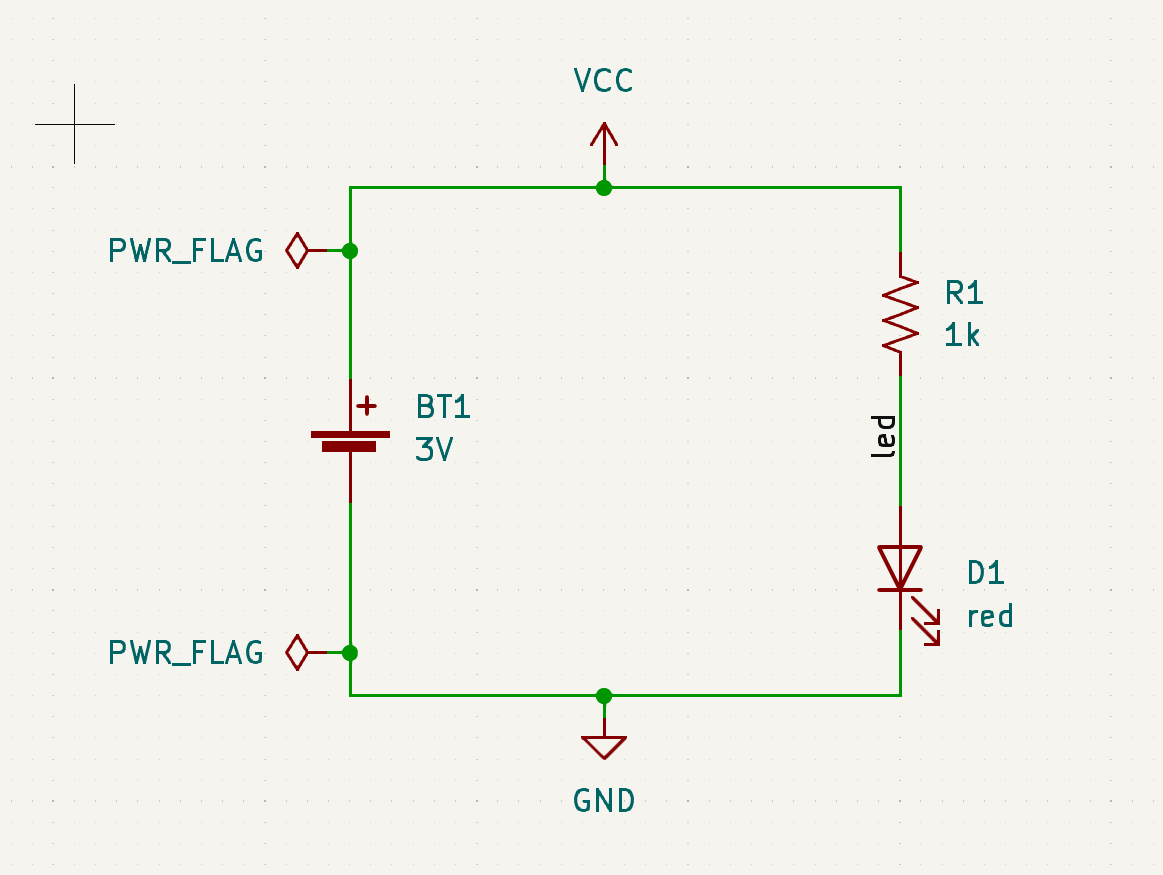
C’è uno speciale simbolo PWR_FLAG nella libreria dei simboli Power che viene usato per risolvere questo problema indicando a KiCad che i collegamenti sono effettivamente pilotati. Aggiungere questo simbolo alle net VCC e GND ed esegui nuovamente il controllo. Quando l’ERC passerà senza alcuna violazione, lo schema sarà completo.
Distinta di base
Un ultimo passaggio facoltativo consiste nel generare una distinta base che elenca tutti i componenti utilizzati nel progetto. Fare clic su Strumenti → Genera distinta materiali….
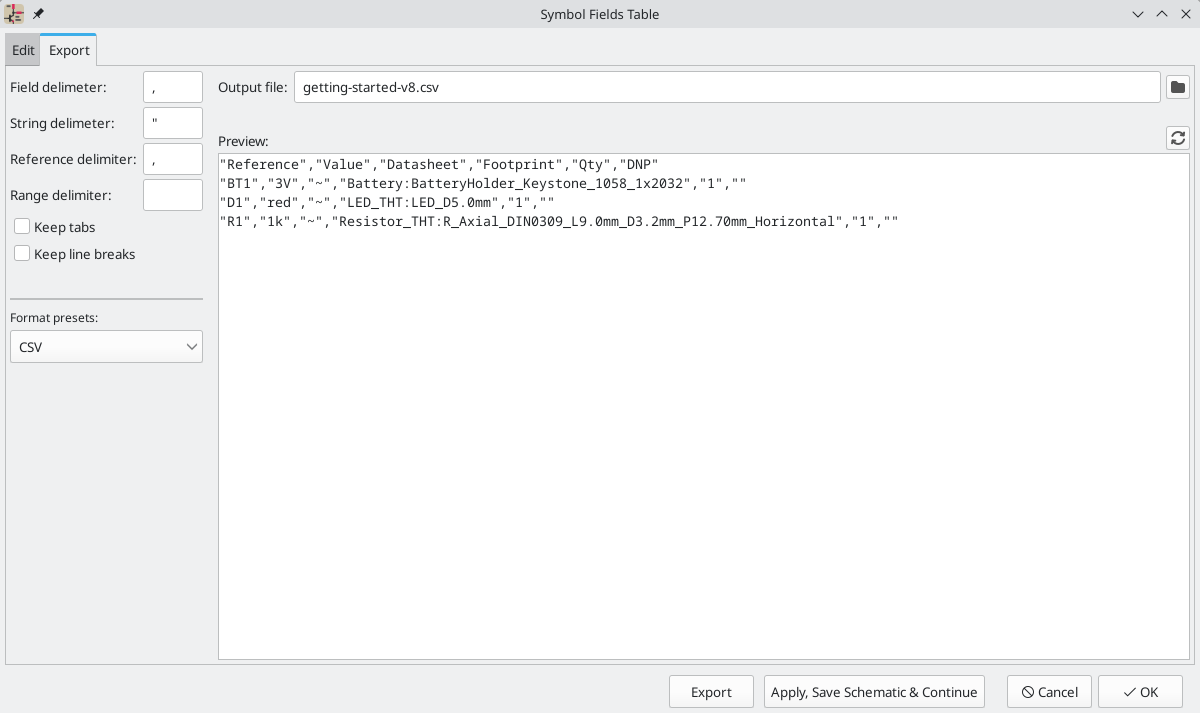
KiCad ha una GUI per l’esportazione della DIBA. È possibile configurare quali metadati dei simboli saranno esportati e come i simboli verranno raggruppati nella scheda Modifica e configurare il formato di uscita nella scheda Esporta.
Per ora, le impostazioni predefinite dovrebbero andare bene, ma è possibile osservare una vista grezza di ciò che verrà esportato nel riquadro di anteprima. Specificare un file di uscita nella scheda Esporta, e premere il pulsante Esporta.
La DIBA dovrebbe assomigliare all’immagine di seguito se aperta in un programma di gestione dei fogli elettronici.

Tutorial parte 3: il circuito stampato
Con lo schema completato, tornare alla finestra del progetto e aprire l’editor del C.S. facendo clic sul pulsante Editor C.S. o aprendo il file dello stampato.
Funzioni di base di modifica del circuito stampato
La navigazione nell’editor di circuiti stampati è la stessa dell’editor schemi elettrici: il pan si fa trascinando con il pulsante centrale del mouse o con il pulsante destro del mouse e per ingrandire invece con la rotellina del mouse o tramite F1/F2.
La parte principale dell’editor dei circuiti stampati. è la zona disegnabile al centro su cui viene steso il progetto della scheda. La barra degli strumenti sul lato sinistro ha varie opzioni di visualizzazione per la scheda, incluse le unità di misura e le modalità di visualizzazione bordo/pieno per tracce, via, pad e zone. La barra degli strumenti a destra dell’area di disegno contiene gli strumenti per la progettazione dello stampato.
Alcuni pulsanti sulla barra degli strumenti a destra hanno un piccolo triangolo nell’angolo
in basso a destra  . Il triangolo indica che il pulsante
ha una tavolozza espandibile contenente diversi strumenti correlati, ad esempio diversi tipi di
dimensioni. Per selezionare uno strumento alternativo, fare clic e tenere premuto il pulsante
finché non viene visualizzata la tavolozza, quindi fare clic sullo strumento alternativo.
Un altro modo per utilizzare le tavolozze è fare clic sul pulsante e trascinare verso sinistra
finché non viene visualizzata la tavolozza, quindi rilasciare il pulsante del mouse quando
lo strumento desiderato viene evidenziato. . Il triangolo indica che il pulsante
ha una tavolozza espandibile contenente diversi strumenti correlati, ad esempio diversi tipi di
dimensioni. Per selezionare uno strumento alternativo, fare clic e tenere premuto il pulsante
finché non viene visualizzata la tavolozza, quindi fare clic sullo strumento alternativo.
Un altro modo per utilizzare le tavolozze è fare clic sul pulsante e trascinare verso sinistra
finché non viene visualizzata la tavolozza, quindi rilasciare il pulsante del mouse quando
lo strumento desiderato viene evidenziato.
|
All’estrema destra c’è il pannello Aspetto e il filtro di selezione. Il pannello Aspetto viene utilizzato per modificare la visibilità, i colori e l’opacità di strati, oggetti e collegamenti dello stampato. Lo strato attivo viene modificato facendo clic sul nome dello strato.
Sotto il pannello Aspetto c’è il filtro di selezione, che abilita e disabilita la selezione di vari tipi di oggetti dello stampato. Ciò è utile per selezionare elementi specifici in un layout affollato.
Configurazione e impilamento della scheda
Prima di iniziare la progettazione dello stampato, impostare le dimensioni pagina e aggiungere informazioni al cartiglio. Fare clic su File → Impostazioni pagina…, quindi scegliere un formato carta appropriato e inserire data, revisione e titolo.

Quindi, andare su File → Impostazione scheda… per definire come verrà prodotto il circuito stampato. Le impostazioni più importanti sono lo stackup, ovvero quali strati di rame e dielettrico avrà il PCB (e i loro spessori) e le regole di progettazione, ad es. dimensioni e spaziatura per tracce e via.
Per impostare lo stackup, aprire la pagina Stackup scheda → Stackup fisico della finestra Impostazione scheda. Per questa guida, lasciare il numero di strati di rame a 2, ma progetti chiaramente più complessi potrebbero richiedere un numero maggiore di strati.
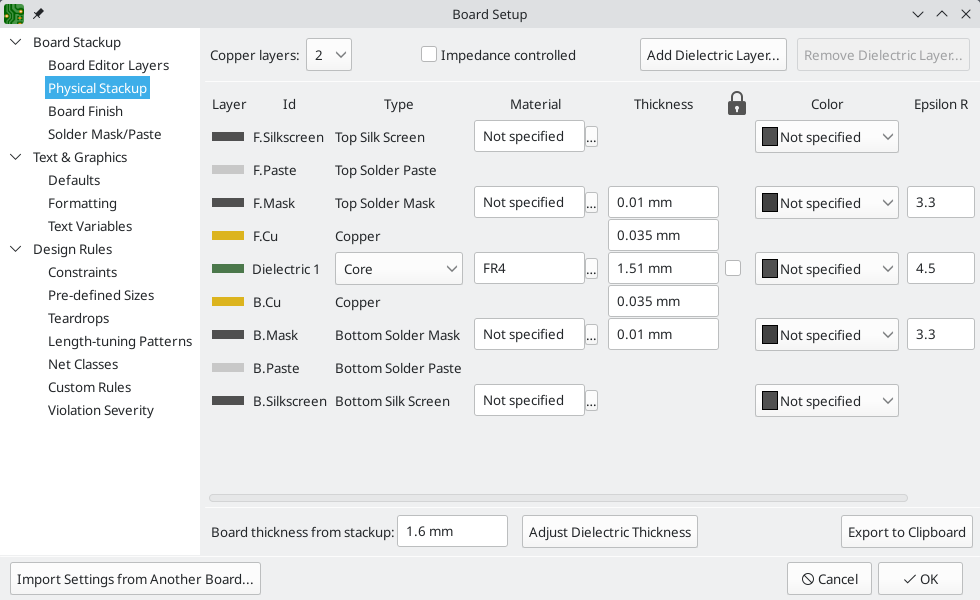
Successivamente, andare alla pagina Regole di progettazione → Vincoli. Le impostazioni in questa pagina specificano le regole di progettazione prioritarie per tutto il progetto della scheda. Ai fini di questa guida, le impostazioni predefinite vanno bene. Tuttavia, per un progetto reale, queste dovrebbero essere impostate in base alle capacità e caratteristiche del fabbricante di circuiti stampati in modo che il progetto del circuito stampato sia realizzabile.

Infine, aprire la pagina Regole di progettazione → Netclass. Una netclass è un insieme di regole di progettazione associate a un gruppo specifico di collegamenti. Questa pagina elenca le regole di progettazione per ciascuna netclass nel progetto e consente di associare specifici collegamenti a determinate netclass (i collegamenti possono anche essere assegnati alle netclass nell’editor dello schema).
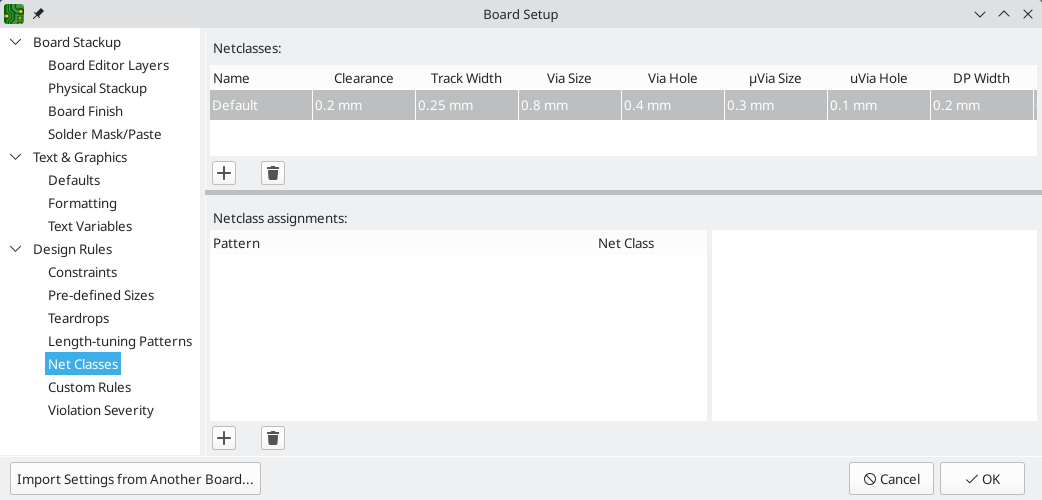
Larghezze e spaziature piste possono essere gestite manualmente dal progettista durante la stesura del C.S., ma l’uso delle netclass è consigliato perché forniscono un modo automatico per gestire e controllare le regole di progettazione.
In questo progetto, non è stato specificata nessuna net class perciò tutti i collegamenti appartengono alla netclass predefinita Default. Altri progetti possono avere più netclass, ciascuna con regole di progettazione diverse. Ad esempio, una scheda potrebbe avere una netclass Alta corrente con piste larghe, o una netclass 50 Ohm con regole di larghezza e distanza specifiche per tracce a impedenza controllata di 50 Ohm.
Importazione cambiamenti dallo schema
Lo schema è completo, ma non ci sono ancora componenti nell layout. Per importare i dati di progettazione dallo schema nel C.S., fare clic su Strumenti → Aggiorna il C.S. dallo schema… o premere F8. C’è anche un pulsante  nella barra strumenti in alto.
nella barra strumenti in alto.
Leggere i messaggi nella finestra Modifiche da applicare, che diranno che i tre componenti nello schema verranno aggiunti alla scheda. Fare clic su Aggiorna C.S., Chiudi e fare clic sull’area di disegno per posizionare le tre impronte. La posizione di ciascuna impronta rispetto alle altre verrà modificata in seguito.
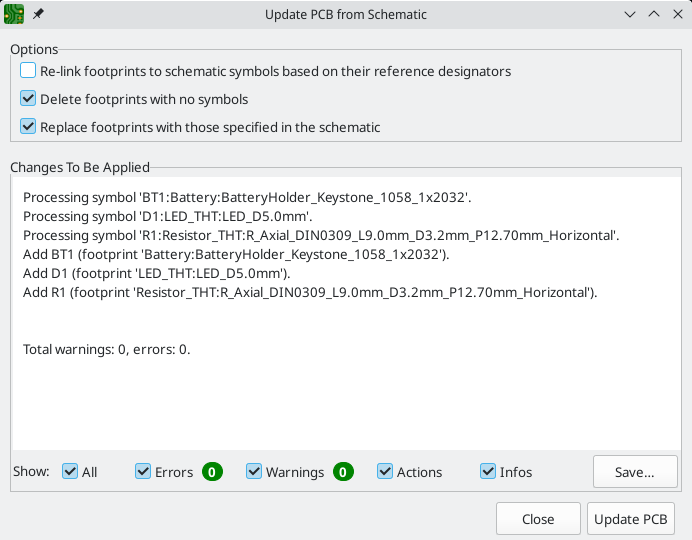

In KiCad, l’aggiornamento del C.S. con le modifiche allo schema è un processo manuale: il progettista decide quando è opportuno aggiornare il C.S. con le modifiche allo schema. Ogni volta che lo schema viene modificato, il progettista deve utilizzare lo strumento Aggiorna il C.S. dallo schema per mantenere lo schema e il layout sincronizzati.
Disegnare il bordo scheda
Ora i tre componenti sono stati posizionati, ma la scheda stessa non è stata definita. La scheda viene definita disegnando il bordo scheda sul livello Edge.Cuts.
Spesso è utile disegnare il borso scheda con una griglia grossolana, rendendo facile ottenere numeri interi per le dimensioni della scheda. Passare a una griglia grossolana selezionando 1mm nel menu a discesa Griglia sopra la zona di lavoro.

Per disegnare sul livello Edge.Cuts, fare clic su Edge.Cuts nella scheda Strati del pannello Aspetto a destra. Scegliere lo strumento rettangolo  nella barra degli strumenti a destra e fare clic sull’area di disegno per piazzare il primo angolo e poi clic ancora per piazzare l’angolo opposto in modo da disegnare un rettangolo che circonda approssimativamente le tre impronte. Anche gli altri strumenti grafici (linea
nella barra degli strumenti a destra e fare clic sull’area di disegno per piazzare il primo angolo e poi clic ancora per piazzare l’angolo opposto in modo da disegnare un rettangolo che circonda approssimativamente le tre impronte. Anche gli altri strumenti grafici (linea  , arco
, arco  , cerchio
, cerchio  , poligono
, poligono  , bezier
, bezier  o una combinazione di questi) possono essere usati per disegnare il bordo della scheda; l’unico requisito è che sia un’unica forma chiusa che non intersechi sé stessa.
o una combinazione di questi) possono essere usati per disegnare il bordo della scheda; l’unico requisito è che sia un’unica forma chiusa che non intersechi sé stessa.
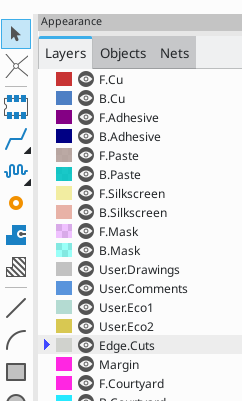
Piazzamento impronte
Il passaggio successivo nel processo di layout è disporre le impronte sulla scheda. In generale, ci sono diverse considerazioni per il posizionamento delle impronte:
-
Alcune impronte possono avere requisiti esatti per la loro posizione, come connettori, indicatori o pulsanti e interruttori.
-
Potrebbe essere necessario posizionare alcuni componenti in base a considerazioni elettriche. I condensatori filtro devono essere vicini ai pin di alimentazione dell’IC associato e i componenti analogici sensibili devono essere lontani da interferenze digitali.
-
Quasi tutti i componenti hanno un "ingombro" (N.d.T. 'courtyard') (o due se sono definiti sia il fronte che il retro). Generalmente gli ingombri non devono intersecarsi.
-
Altrimenti i componenti dovrebbero essere posizionati per facilitare lo sbroglio. I componenti collegati dovrebbero generalmente essere vicini tra loro e disposti in modo da ridurre al minimo la complessità dello sbroglio. La ratsnest (le linee sottili che indicano le connessioni tra le piazzole) è utile per determinare come posizionare al meglio le impronte rispetto ad altre impronte.
Ai fini di questa guida, l’unico obiettivo del posizionamento è rendere il processo di sbroglio il più semplice possibile.
Iniziare spostando il supporto della batteria BT1 sul lato posteriore della scheda. Fare clic per selezionarlo, quindi premere M per spostarlo. Premere F per girarlo sul lato opposto; ora appare specchiato e le sue piazzole sono cambiate da rosso a blu.
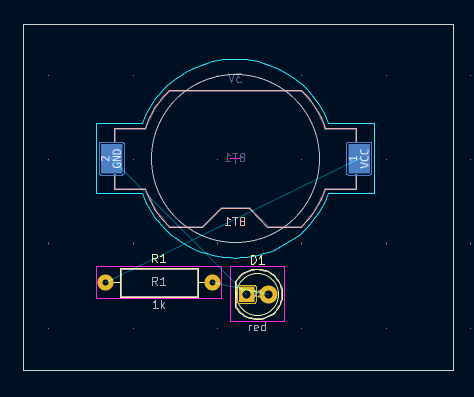
Tutti gli strati del C.S. sono visualizzati dal lato anteriore della scheda. Le impronte sul fondo della scheda sono quindi capovolte e appaiono specchiate.
Ogni strato della scheda ha un colore univoco, mostrato dai campioni di colore nella scheda Livelli del pannello Aspetto. Nello schema colori predefinito, gli elementi sullo strato F.Cu (rame anteriore) sono rossi, mentre gli elementi sullo strato B.Cu (rame posteriore) sono blu.
Ora posizionare gli altri due componenti. Uno alla volta, selezionare ciascun componente, quindi spostarlo e ruotarlo con M e R. Osservare le linee dei collegamenti (ratsnest) tra le piazzole per scegliere la disposizione più semplice dei componenti; una buona disposizione lascerà le linee intricate. La schermata sotto mostra una possibile disposizione.
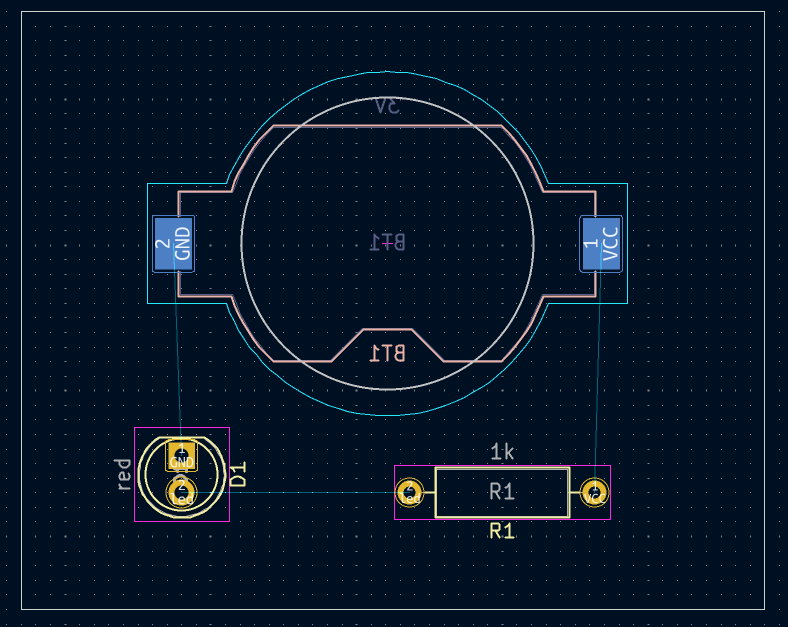
Sbroglio piste
Con i componenti a posto, è il momento di collegare le piazzole con le piste di rame.
La prima pista verrà disegnata sulla parte anteriore (fronte) della scheda, quindi cambiare lo strato attivo in "F.Cu" nella scheda strati del pannello Aspetto.
Fare clic su Sbroglia tracce  nella barra degli strumenti a destra o premere X. Fare clic sulla piazzola "led" di "D1". La ratsnest indica che c’è una connessione non instradata alla piazzola "led" di "R1", quindi fare clic su quella piazzola per tracciare una pista che collega le due piazzole. Cliccando sulla seconda piazzola si completa la pista. La linea Ratsnest tra i piedini
nella barra degli strumenti a destra o premere X. Fare clic sulla piazzola "led" di "D1". La ratsnest indica che c’è una connessione non instradata alla piazzola "led" di "R1", quindi fare clic su quella piazzola per tracciare una pista che collega le due piazzole. Cliccando sulla seconda piazzola si completa la pista. La linea Ratsnest tra i piedini led non è più disegnata perché la connessione è stata realizzata in rame.
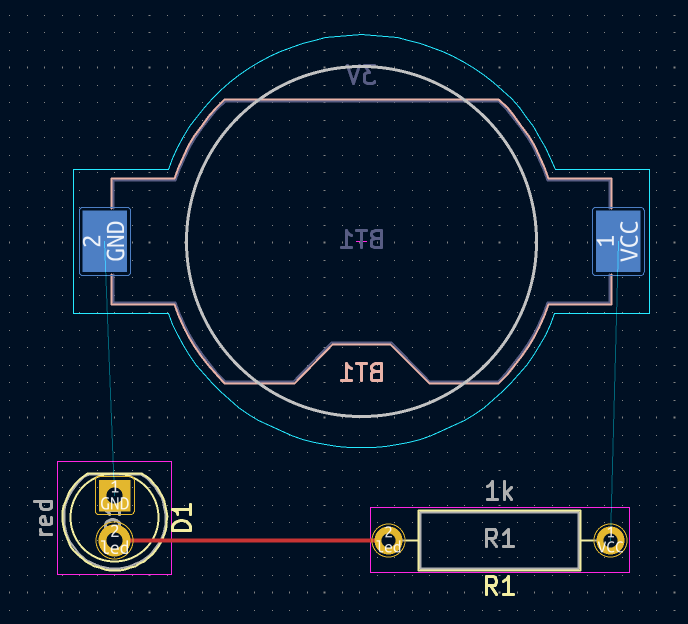
Ora tracciare una pista tra le piazziole GND di BT1 e D1, iniziando dalla piazzola BT1 sul retro della scheda. Notare che il livello attivo è cambiato automaticamente in B.Cu dopo aver fatto clic sulla piazzola BT1. Fare clic sulla piazzola D1 per terminare la pista.
Mentre BT1 ha piazzole a montaggio superficiale che si trovano solo nella parte inferiore della scheda, D1 ha piazzole con foro passante che possono collegarsi alle piste sia sulla parte anteriore che su quella posteriore. Le piazzole passanti sono un modo per creare una connessione tra più strati. In questo caso, D1 è un componente sul lato anteriore della scheda, ma i suoi fori passanti vengono utilizzati per connettersi a una pista sul retro della scheda.
Un altro modo per stabilire una connessione tra strati è tramite un via. Iniziare lo sbroglio dalla piazzola VC di BT1 sul retro della scheda. Premere V e fare clic a metà strada tra BT e R1 per inserire un via, operazione che commuta anche lo strato attivo su F.C. Completare la pista sul lato superiore della scheda facendo clic sulla piazzola VCC di R1.
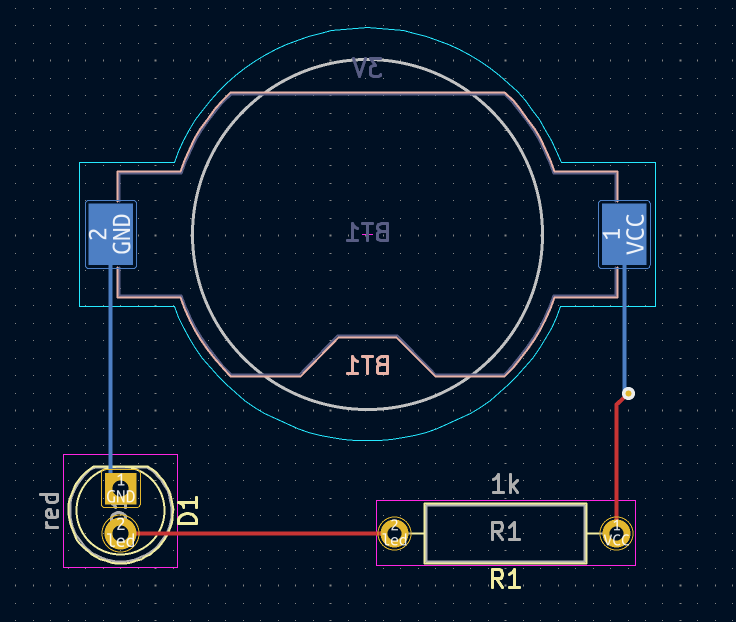
A questo punto, tutte le connessioni (net) sono sbrogliate. Ciò può essere confermato guardando la schermata di stato in basso a sinistra della finestra, dove il numero di connessioni non sbrogliate è indicato come 0.
Piazzamento zone rame
Le zone di rame sono regioni di rame con un collegamento (net) associato. Le zone si collegano automaticamente agli oggetti di rame che appartengono allo stesso collegamento ed evitano gli oggetti che appartengono ad altri collegamenti. Le zone sono spesso utilizzate per connessioni di terra e di alimentazione perché forniscono una connessione a impedenza inferiore rispetto alle piste.
Aggiungere una zona GND sul retro scheda passando allo strato di rame inferiore e facendo clic sul pulsante Aggiungi una zona piena  nella barra degli strumenti di destra. Fare clic sul C.S per posizionare il primo vertice della zona.
nella barra degli strumenti di destra. Fare clic sul C.S per posizionare il primo vertice della zona.
Nella finestra di dialogo Proprietà zona rame che appare, selezionare il collegamento GND e assicurarsi che sia selezionato lo strato B.Cu. Fare clic su OK, quindi fare clic per posizionare gli altri tre vertici della zona. Fare doppio clic quando si posiziona l’ultimo vertice per completare la zona.

Il contorno zona viene visualizzato sull’area di disegno, ma la zona non è ancora riempita: non c’è rame nell’area della zona e pertanto la zona non effettua alcun collegamento elettrico. Riempire la zona con Modifica → Riempi tutte le zone (B). Il rame è stato aggiunto alla zona, ma non si collega alle piazzole e alle piste VCC o led ed è tagliato dal bordo della scheda. Si sovrappone alla pista GND disegnata in precedenza e si collega alla piazzola GND tramite piste sottili. Si tratta di supporti termici che facilitano la saldatura della piazzola. I supporti termici e altre impostazioni della zona possono essere modificati nella finestra di dialogo delle proprietà della zona.
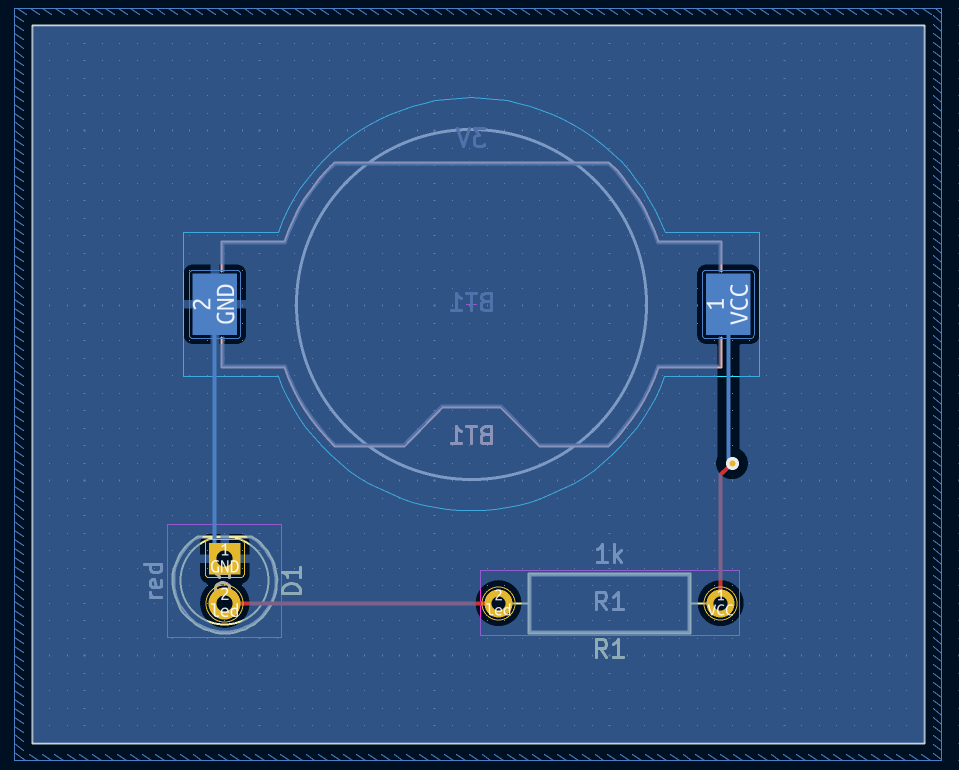
In KiCad, le zone non vengono riempite automaticamente quando vengono disegnate o modificate per la prima volta, o quando le impronte al loro interno vengono spostate. Le zone vengono riempite riempiendole manualmente e quando si eseguono i controlli regole elettriche. Assicurarsi che i riempimenti delle zone siano aggiornati prima di generare file di fabbricazione.
A volte le zone riempite possono rendere difficile vedere altri oggetti in una scheda affollata. Le zone possono venire nascoste a parte i confini tramite il pulsante Mostra solo i confini delle zone  sulla barra degli strumenti a sinistra. Le zone mantengono il loro stato riempito quando vengono mostrati solo i contorni: nascondere il riempimento di una zona non equivale a svuotarla.
sulla barra degli strumenti a sinistra. Le zone mantengono il loro stato riempito quando vengono mostrati solo i contorni: nascondere il riempimento di una zona non equivale a svuotarla.
Le zone possono anche essere rese trasparenti utilizzando il pannello Aspetto e i livelli inattivi possono anch’essi essere nascosti o oscurati utilizzando le Opzioni di visualizzazione dei livelli nel pannello Aspetto.
Regole di progettazione
Il controllo delle regole di progettazione (DRC) è l’equivalente del controllo delle regole elettriche del circuito stampato ma per lo schema elettrico. Il DRC cerca errori di progettazione come discrepanze tra lo schema e la scheda, regioni di rame che hanno una distanza insufficiente o sono in cortocircuito e tracce che non si collegano a nulla. Si possono scrivere anche regole personalizzate. Per visualizzare l’elenco completo delle regole di progettazione che vengono controllate e per regolarne l’importanza, andare su File → Impostazione scheda… → Regole di progettazione → Importanza violazioni. Si consiglia di eseguire il DRC e correggere tutti gli errori prima di generare alcun file di fabbricazione.
Eseguire un controllo DRC con Ispeziona → Verifica regole di progettazione o utilizzare il pulsante  nella barra degli strumenti in alto. Fare clic su Esegui DRC. Una volta completati i controlli, non dovrebbero essere segnalati errori o avvisi. Chiudere la finestra DRC.
nella barra degli strumenti in alto. Fare clic su Esegui DRC. Una volta completati i controlli, non dovrebbero essere segnalati errori o avvisi. Chiudere la finestra DRC.
Ora causare intenzionalmente un errore DRC spostando l’impronta della resistenza in modo che si sovrapponga all’area riempita della zona. Utilizzare D (Trascina) per spostare leggermente l’impronta della resistenza mantenendo le tracce attaccate alle sue piazzole. Ciò crea una violazione della distanza perché le piazzole VCC e led del resistore sono in cortocircuito dal riempimento della zona GND. Normalmente questo problema verrebbe risolto riempiendo nuovamente la zona, ma non riempire ancora la zona.

Eseguire nuovamente il DRC, ma assicurarsi di deselezionare la casella di controllo Aggiorna tutte le zone prima di eseguire il DRC. Il DRC segnala 6 violazioni: per ciascuna piazzola di R1, c’è una violazione di spazio tra la piazzola e la zona, un’altra violazione di spazio tra il foro passante della piazzola e la zona e una terza violazione dove l’apertura della maschera di saldatura espone il rame di due diverse connessioni (lo riempimento GND e la pista connessa alla piazzola). Le frecce indicano ciascuna violazione nell’area di disegno. Facendo clic su ciascun messaggio di violazione si ingrandisce la visualizzazione sulla rispettiva violazione.

Chiudere la finestra di dialogo DRC, premere B per riempire la zona e rieseguire il DRC. In alternativa, selezionare la casella di controllo Riempire tutte le zone prima di eseguire il DRC ed eseguire nuovamente il DRC. Tutte le violazioni sono state corrette.
Visualizzatore 3D
KiCad offre un visualizzatore 3D utile per ispezionare il C.S. . Aprire il visualizzatore 3D con Visualizza → Visualizzatore 3D. Effettuare la panoramica trascinando con il pulsante centrale del mouse e orbitare trascinando con il pulsante sinistro del mouse. Orbitare attorno al circuito stampato per vedere il LED e il resistore in alto e il supporto della batteria in basso.
È disponibile una modalità raytracing, che è più lenta ma offre un rendering più accurato. Passare alla modalità raytracing con Preferenze → Raytracing.

Molte delle impronte nella libreria di KiCad sono dotate di modelli 3D, incluse tutte le impronte utilizzate in questa guida. Alcune impronte non vengono fornite con modelli 3D, ma gli utenti possono aggiungerne di propri.
File per la fabbricazione
Una volta completata la progettazione della scheda, il passaggio finale consiste nel generare i file necessari per la fabbricazione in modo che la scheda possa essere prodotta.
Aprire la finestra di dialogo Traccia, tramite File → Traccia…. Questa finestra di dialogo può tracciare il progetto in diversi formati, ma Gerber è solitamente il formato giusto per l’ordine di un C.S. da un produttore.
Specificare una cartella di uscita in modo che i file tracciati vengano raccolti in essa. Altrimenti, le impostazioni predefinite vanno bene, ma assicurarsi che tutti i livelli necessari siano selezionati: includere i livelli di rame (*.Cu), il contorno della scheda (Edge.Cuts), la maschera di saldatura (*.Mask) e serigrafia (*.Silkscreen). Gli strati della pastasalda (*.Paste) sono utili per produrre gli stencil per la pastasalda. Gli strati adesivi (*.Adhesive) sono necessari solo se alcuni componenti verranno incollati alla scheda durante l’assemblaggio. Altri strati possono essere utili da tracciare, ma in genere non sono necessari per la fabbricazione di circuiti stampati.
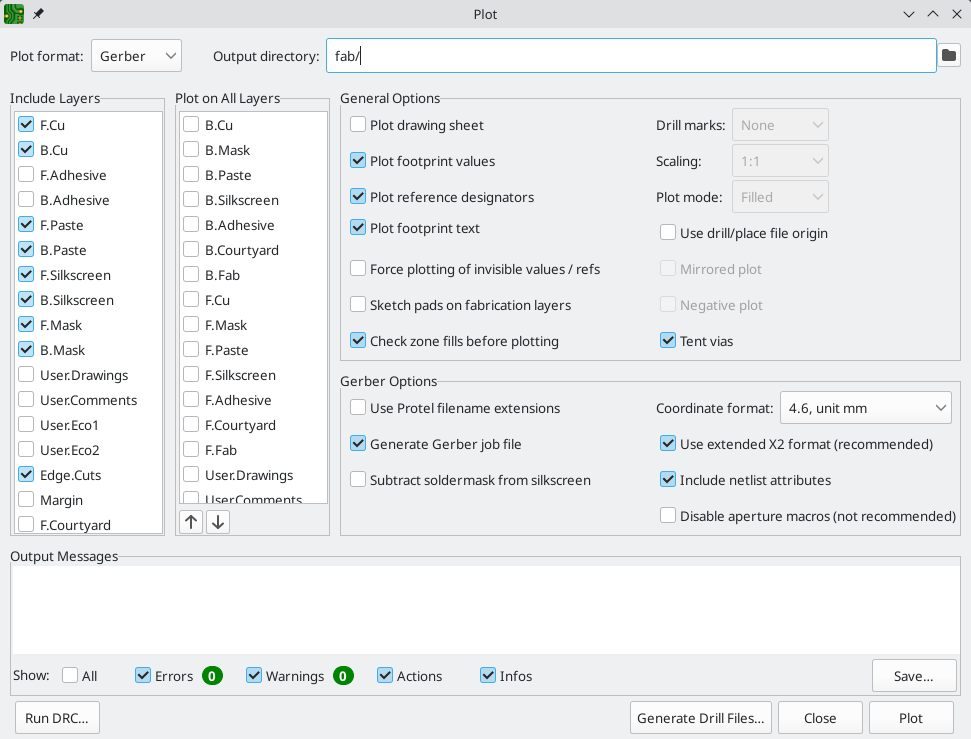
Fare clic su Traccia per generare i file Gerber. Fare inoltre clic su Genera file forature… e quindi su Genera file forature per creare file specificando la posizione di tutti i fori che verranno praticati nella scheda. Infine, chiuderela finestra di dialogo Traccia. Il progetto è finito.
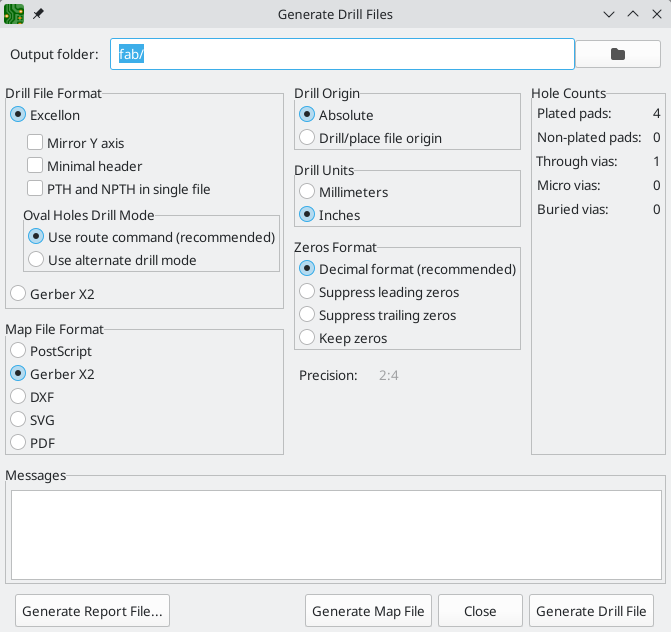
Tutorial parte 4: simboli e impronte personalizzati
Il circuito può essere migliorato aggiungendo un interruttore per accendere e spegnere il LED. Il processo per aggiungere questo interruttore richiederà la creazione di una nuova libreria di simboli e impronte, il disegno di un simbolo di interruttore e la creazione di un’impronta per l’interruttore.
L’interruttore specifico che verrà utilizzato in questa guida è NKK M2011S3A1W03, un interruttore a levetta SPST. Potrebbero essere utilizzati molti altri interruttori, ma potrebbe essere necessario modificare la numerazione dei pin e l’ampiezza dell’ingombro.
Nozioni base su librerie e tabella librerie
Simboli e impronte sono organizzati in librerie. Una libreria può contenere simboli o impronte, ma non entrambi.
KiCad tiene traccia delle librerie di simboli e delle librerie di impronte dell’utente rispettivamente nella tabella delle librerie di simboli e nella tabella delle librerie di impronte. Ogni tabella delle librerie è un elenco di nomi di librerie e la posizione in cui ciascuna libreria esiste sul disco.
Oltre alle tabelle globali delle librerie di simboli e impronte, sono disponibili anche le tabelle delle librerie specifiche del progetto per simboli e impronte. I simboli e le impronte aggiunti alle tabelle globali sono disponibili in tutti i progetti, mentre i simboli e le impronte aggiunti alle tabelle specifiche del progetto sono disponibili solo per quel progetto specifico. Gli utenti possono aggiungere le proprie librerie alle tabelle delle librerie globali o alle tabelle specifiche del progetto.
Le tabelle delle librerie di simboli possono essere visualizzate o modificate con Preferenze → Gestisci librerie di simboli… nelle finestre dell’Editor degli schemi elettrici o dell’Editor dei simboli. Le tabelle delle librerie di impronte possono essere visualizzate o modificate con Preferenze → Gestisci librerie di impronte… nell’editor dei circuiti stampati o nell’editor delle impronte. È possibile accedere a entrambe le tabelle di librerie anche dalla finestra di gestione del progetto.

Spesso i percorsi delle librerie sono definiti con variabili di sostituzione del percorso. Ciò consente a un utente di spostare tutte le proprie librerie in una nuova posizione senza modificare le tabelle delle librerie. L’unica cosa che deve essere cambiata è la definizione della variabile in modo che punti alla nuova posizione. Le variabili di sostituzione del percorso di KiCad vengono modificate con Preferenze → Configura percorsi… nella Gestione del progetto o in qualsiasi finestra di editing.
Una utile variabile di sostituzione del percorso è ${KIPRJMOD}. Questa variabile punta sempre alla cartella del progetto corrente, quindi può essere utilizzata per includere librerie specifiche del progetto archiviate nella cartella del progetto.
Alla prima esecuzione, KiCad chiede all’utente di impostare la tabella delle librerie di simboli e tabella delle librerie delle impronte. Per ripetere questa impostazione, eliminare o rinominare i file della tabella librerie di simboli o della tabella librerie di impronte. Effettuare un backup delle tabelle prima di eliminarle.
La posizione dei file della tabella librerie di simboli e di impronte dipende dal sistema operativo.
-
Windows:
%APPDATA%\kicad\9.0\sym-lib-tablee%APPDATA%\kicad\9.0\fp-lib-table -
Linux:
~/.config/kicad/9.0/sym-lib-tablee~/.config/kicad/9.0/fp-lib-table -
macOS:
~/Library/Preferences/kicad/9.0/sym-lib-tablee~/Library/Preferences/kicad/9.0/fp-lib-table
Creazione nuove librerie globali o di progetto
Il primo passo per disegnare un nuovo simbolo o impronta è scegliere una libreria nella quale memorizzarlo. Per questa guida, il simbolo e l’impronta dell’interruttore verranno inseriti nelle nuove librerie specifiche del progetto.
Aprire l’editor dei simboli dal Project Manager. Fare clic su File → Nuova libreria e selezionare Progetto. Scegliere un nome per la nuova libreria (ad esempio getting-started.kicad_sym) e salvarla nella cartella del progetto. La nuova libreria vuota è ora selezionata nel riquadro Librerie a sinistra ed è stata automaticamente aggiunta alla tabella delle librerie del progetto (controllare la scheda Librerie specifiche del progetto in Preferenze → Gestisci librerie di simboli…).
Creazione nuovi simboli
Ora crea il simbolo dell’interruttore nella nuova libreria. Con la libreria getting-started selezionata nel riquadro Librerie, fare clic su File → Nuovo simbolo…. Nel campo Nome simbolo, inserire il codice prodotto: M2011S3A1W03. I simboli degli interruttori devono avere riferimenti che inizino con SW, quindi modificare il campo Riferimento predefinito in SW. Tutti gli altri campi possono rimanere quelli predefiniti.
Nel pannello Librerie, il simbolo M2011S3A1W03 ora appare sotto la libreria getting-started. Nell’area di disegno, una croce indica il centro dell’impronta ed è stato aggiunto del testo per il riferimento. Per ora, spostare il testo lontano dal centro dell’impronta per toglierlo di mezzo.
Piedini del simbolo
Iniziare a disegnare il simbolo aggiungendo un pin. Questo simbolo non avrà un pin 1, quindi si inizierà con un pin numero 2. Fare clic sul pulsante Aggiungi pin  sulla barra degli strumenti a destra. Apparirà la finestra di dialogo Proprietà pin. Impostare le proprietà del pin come segue:
sulla barra degli strumenti a destra. Apparirà la finestra di dialogo Proprietà pin. Impostare le proprietà del pin come segue:
-
Pin name:
A -
Pin number:
2 -
Electrical type:
Passive -
Orientation:
Right -
X Position:
-200 mils -
Y Position:
0
Fare clic su OK e poi sull’area di disegno per posizionare il piedino. Se il pin si è spostato dopo aver fatto clic su OK, potrebbe essere necessario modificare nuovamente le proprietà del piedino (fare doppio clic sul piedino o fare clic con il pulsante destro del mouse sul piedino → Proprietà…) per impostare la posizione corretta.
| Si consiglia vivamente di utilizzare sempre mil (o pollici) nell’editor degli schemi e in quello dei simboli, in particolare per i pin dei simboli. Mescolare unità imperiali e metriche darà luogo a pin dei simboli impossibili da collegare correttamente perché non allineati con fili o altri pin. Le librerie KiCad usano una griglia da 50 mil per i loro pin; l’utilizzo di un sistema di unità diverso impedirà ai simboli e agli schemi di connettersi con i simboli incorporati di KiCad. Si noti che, a differenza dell’editor di C.S., le unità nello schema non hanno alcun significato fisico. |
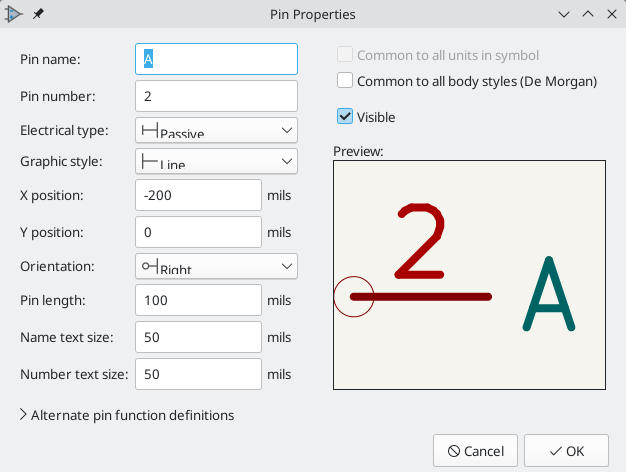
Aggiungere un secondo piedino, ma questa volta senza lo strumento Aggiungi piedino. Invece, premere Ins. Un nuovo pin numero 3 viene aggiunto al simbolo, appena sotto il piedino 2.
| In molti posti in KiCad, la pressione di Ins ripeterà l’ultima azione. La posizione del nuovo elemento verrà spostata e la numerazione incrementata automaticamente, se possibile. Nell’editor del simbolo, ciò può essere usato per piazzare velocemente molti piedini. Nell’editor degli schemi, può essere usato per piazzare ripetutamente un componente, o per etichettare i piedini di un grosso componente con etichette numerate. Ins può essere utile, infine, anche nell’editor delle impronte e del circuito stampato. |
Vogliamo che il Pin 3 si trovi a destra del simbolo dell’interruttore, quindi ne modificheremo le proprietà per cambiarne la posizione e l’orientamento. Invece di utilizzare la finestra di dialogo Proprietà Pin, questa volta possiamo utilizzare il Pannello Proprietà. Si tratta di un pannello ancorato sul lato sinistro dell’area di modifica che consente di visualizzare e modificare le proprietà dell’oggetto o degli oggetti selezionati. Per visualizzare o nascondere il Pannello Proprietà, utilizzare il pulsante  nella barra degli strumenti a sinistra.
nella barra degli strumenti a sinistra.
Con il pin 3 selezionato, utilizzare il pannello Proprietà per impostarne le proprietà come segue:
-
Pin Name:
B -
Position X:
200 mils -
Position Y:
0 -
Orientation:
Left
| Il pannello Proprietà è disponibile in tutti gli editor KiCad (Schema, Scheda, Simbolo e Impronta). |
Caratteristiche grafiche
Con i piedini piazzati, usare gli strumenti cerchio  e linea
e linea  per far assomigliare il simbolo ad un interruttore SPST. Per realizzare questo passo, può essere utile impostare la griglia ad un valore più fine: clic destro sull’area di disegno e selezionare una griglia più piccola nel sottomenu Griglia. Dopo aver aggiunto le forme grafiche, impostare nuovamente la griglia a 50 mils.
per far assomigliare il simbolo ad un interruttore SPST. Per realizzare questo passo, può essere utile impostare la griglia ad un valore più fine: clic destro sull’area di disegno e selezionare una griglia più piccola nel sottomenu Griglia. Dopo aver aggiunto le forme grafiche, impostare nuovamente la griglia a 50 mils.
| Le griglie fini sono utili per le grafiche, ma i piedini del simbolo devono essere sempre piazzati su una griglia di 50 mils (1.27 mm). I piedini non allineati alla griglia da 50 mils non si connetteranno ai fili nello schema. |
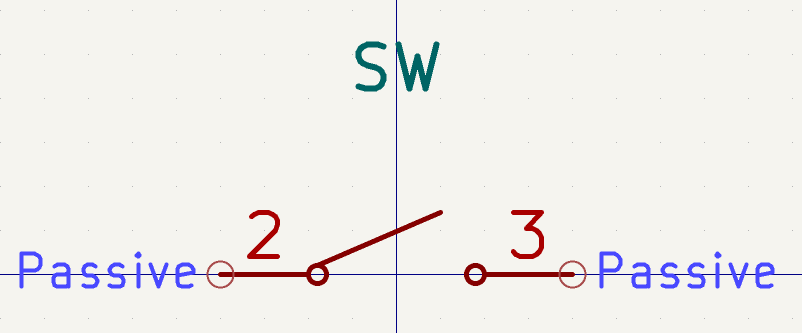
Proprietà del simbolo
Ora modificare le proprietà del simbolo con File → Proprietà simbolo, o fare doppio clic sull’area di disegno. Cambiare il campo Valore a M2011S3A1W03, e aggiungere spst switch toggle al campo Parolechiave per rendere più facile trovare il simbolo con la ricerca. Per questo simbolo, i nomi dei pin non aggiungono alcuna informazione utile, perciò deselezionare Mostra nomi dei pin per rendere il simbolo visualmente più semplice.
Dopo aver fatto clic su OK, spostare il testo del campo valore più in basso in modo che non si sovrapponga alla grafica del simbolo.

Il simbolo ora è completo. Salvarlo e proseguire con la creazione di un’impronta.
Creazione di nuove impronte
Aprire l’editor delle impronte e creare una nuova libreria impronte specifica del progetto di nome getting-started.pretty (File → Nuova libreria…). Come con le librerie di simboli, la nuova libreria di impronte viene aggiunta alla tabella librerie del progetto. Con la nuova libreria selezionata nel pannello delle librerie, creare una nuova impronta (File → Nuova impronta…). Modificare le proprietà dell’impronta (il pulsante  nella barra strumenti superiore) e importare le seguenti proprietà:
nella barra strumenti superiore) e importare le seguenti proprietà:
-
Footprint name:
Switch_Toggle_SPST_NKK_M2011S3A1x03 -
Value:
Switch_Toggle_SPST_NKK_M2011S3A1x03 -
Component type:
Through hole
Piazzole impronte
L’interruttore ha due piedini, numerati nella scheda tecnica come 2 e 3 e distanziati di 4,7 mm l’uno dall’altro. Per facilitare il posizionamento, regolare la griglia in modo che corrisponda alla spaziatura delle piazzole. Aprire le proprietà della griglia facendo clic destro sul pulsante  nella barra a sinistra e selezionare *Modifica griglia…. Aggiungere una nuova griglia con il pulsante del segno più, in basso. Impostare la nuova dimensione X della griglia a
nella barra a sinistra e selezionare *Modifica griglia…. Aggiungere una nuova griglia con il pulsante del segno più, in basso. Impostare la nuova dimensione X della griglia a 4.7 mm. Accettare la modifica nella finestra di dialogo, quindi tornare all’area di lavoro e passare alla nuova griglia nell’elenco a discesa della barra superiore se non è già selezionata.
Per convenzione, le impronte a foro passante hanno il pin 1 situato in (0,0) e sono orientate con il pin 1 in alto a sinistra. La versione SPST di questo interruttore non ha il pin 1, quindi l’impronta lascerà (0,0) vuoto e posizionerà i pad 2 e 3 a (0, 4.7 mm) e (0, 9.4 mm). Si noti che nel sistema di coordinate predefinito di KiCad, l’asse Y positivo è orientato verso il basso.
| Le coordinate X e Y del puntatore vengono visualizzate nella barra di stato nella parte inferiore della finestra. Si può usare questa informazione per controllare le coordinate quando si disegna o posiziona qualcosa. |
Usare lo strumento Aggiungi piazzola  nella barra degli strumenti a destra per posizionare una piazzola una passo della griglia sotto l’origine, che è (0, 4,7 mm). Premere Esc per uscire dallo strumento piazzola, quindi fare doppio clic sulla piazzola per modificarne le proprietà. Modificare il numero della piazzola in
nella barra degli strumenti a destra per posizionare una piazzola una passo della griglia sotto l’origine, che è (0, 4,7 mm). Premere Esc per uscire dallo strumento piazzola, quindi fare doppio clic sulla piazzola per modificarne le proprietà. Modificare il numero della piazzola in 2 e verificare che la posizione sia corretta. I piedini dell’interruttore misurano 1,17 mm x 0,8 mm, il che dà una diagonale (dimensione massima del piedino) di 1,42 mm. Impostare quindi il diametro del foro su 1,42 mm + 0,2 mm = 1,62 mm e il diametro della piazzola a 1,62 mm + 2*0,15 mm = 1,92 mm per fornire un anulare sufficiente.
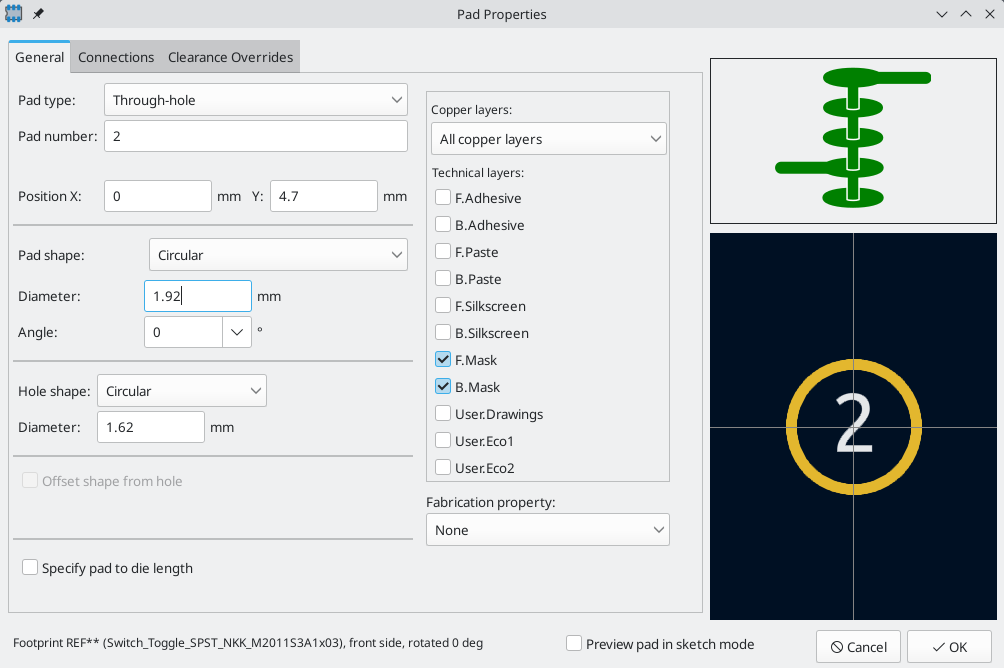
Ora usare nuovamente lo strumento Aggiungi piazzola per posizionare l’altra piazzola a (0,0 , 9.4 mm). Si noti che il numero della piazzola viene incrementato automaticamente e le proprietà, tra cui la dimensione della piazzola e la dimensione del foro, vengono copiate dalla piazzola precedente.
Con entrambi i cuscinetti posizionati, gli anulari appaiono leggermente piccoli. L’interruttore sarà più facile da saldare e meccanicamente più robusto se gli anelli anulari saranno più grandi. Aumentare lo spessore dell’anulare da 0,15 mm a 0,3 mm modificando la piazzola 2 e cambiando la dimensione del piazzola a 1,62 mm + 2*0,3 mm = 2,22 mm. Non modificare la dimensione del foro. Tenere presente che il campo della dimensione della piazzola accetta espressioni matematiche, quindi è possibile inserire direttamente "1,62+2*0,3" e verrà valutato 2,22 mm.
| Molte caselle di testo in KiCad supportano espressioni matematiche, inclusa l’unità conversioni. |
Apportare la stessa modifica all’anulare anche all’altra piazzola. Come scorciatoia, fare clic con il pulsante destro del mouse sulla piazzola 2, fare clic su Invia proprietà piazzola ad altre piazzole…, quindi fare clic su Cambia piazzole nell’impronta corrente.
Grafiche impronte
Una buona impronta avrà il contorno del componente disegnato esattamente sullo strato di fabbricazione (F.Fab), un contorno leggermente più grande sullo strato serigrafico (F.Silkscreen) e un ingombro (F.Courtyard) che circonda l’intera impronta per evitare sovrapposizioni con altre impronte.
Passare allo strato di fabbricazione anteriore facendo clic su F.Fab nel pannello Strati a destra. Il bordo di fabbricazione deve corrispondere esattamente alle dimensioni fisiche del componente, che è largo 7.9 mm e alto 13 mm. Usare gli strumenti linea  , rettangolo
, rettangolo  o poligono
o poligono  per disegnare il contorno del componente come mostrato nella schermata sotto. Un modo per posizionare con precisione il contorno è creare una nuova griglia con le corrette spaziature X e Y come abbiamo fatto per le piazzole. Assicurarsi di deselezionare la casella Collegato nella finestra delle impostazioni della griglia per permettere spaziature X e Y diseguali. Poi regolare l’origine della griglia facendo clic destro sul pulsante
per disegnare il contorno del componente come mostrato nella schermata sotto. Un modo per posizionare con precisione il contorno è creare una nuova griglia con le corrette spaziature X e Y come abbiamo fatto per le piazzole. Assicurarsi di deselezionare la casella Collegato nella finestra delle impostazioni della griglia per permettere spaziature X e Y diseguali. Poi regolare l’origine della griglia facendo clic destro sul pulsante  e selezionando Origine griglia….
e selezionando Origine griglia….
Configurare l’origine e la spaziatura griglia come di seguito:
-
X griglia:
7.9 mm -
Y griglia:
13 mm -
Origine X: 7,9 mm / 2 =
3,95 mm -
Origine Y: 4,7 mm - (13 mm / 2) =
-1,8 mm.
Di seguito è riportato il disegno di fabbricazione completato, con le coordinate degli angoli annotate.
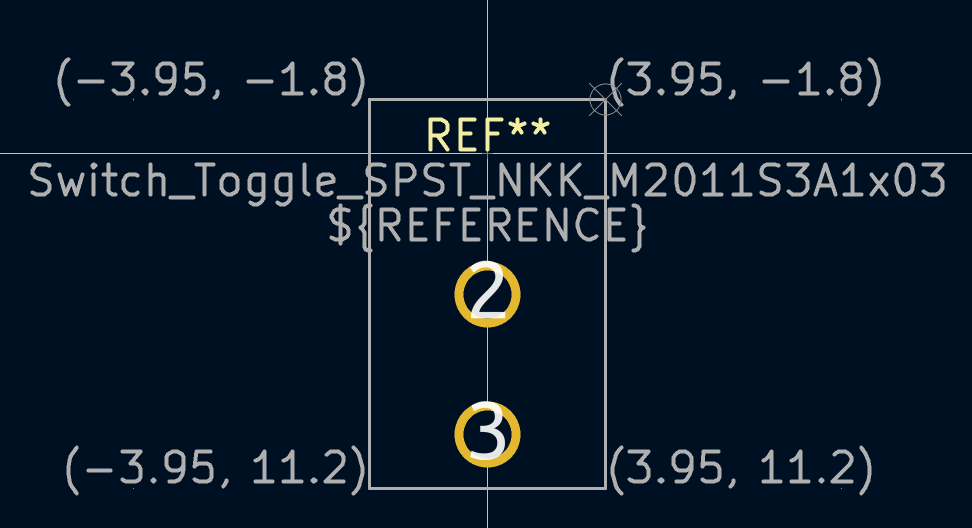
Successivamente, passare allo strato F.Silkscreen. Vogliamo che il contorno della serigrafia si trovi appena all’esterno del contorno del componente, in modo che le linee della serigrafia vengano spostate verso l’esterno dal disegno di fabbricazione di 0,11 mm (metà della larghezza della linea di fabbricazione di 0,10 mm, più metà della larghezza della linea della serigrafia di 0,12 mm). Le coordinate esatte sono mostrate nella schermata qui sotto e le impostazioni utili della griglia sono:
-
Griglia X: 7,9 mm + 2 * 0,11 mm =
8,12 mm -
Griglia Y: 13 mm + 2 * 0,11 mm =
13,22 mm -
Origine X: 8,12 mm / 2 =
4,06 mm -
Origine Y: -1,8 mm - 0,11 mm =
-1,91 mm
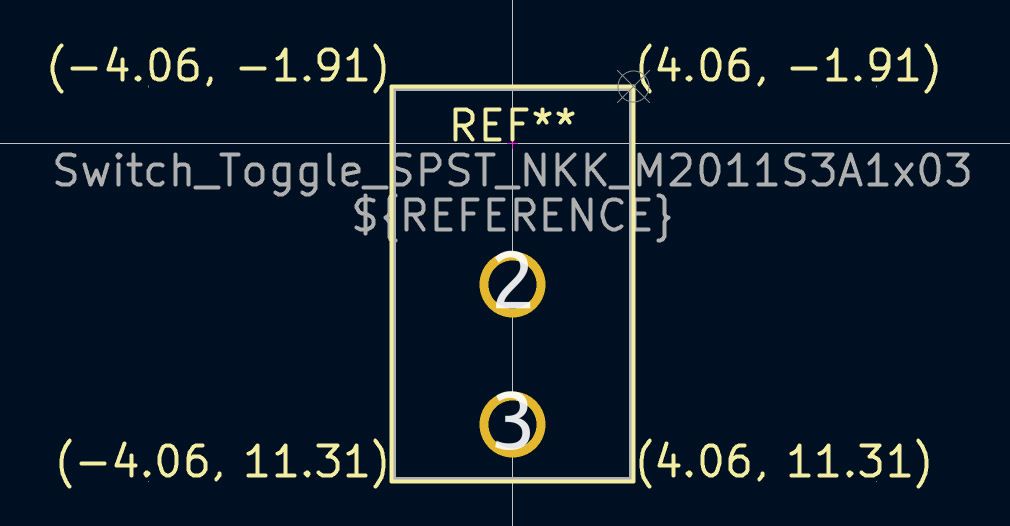
Infine, selezionare lo strato F.Courtyard. Vogliamo che il contorno dell’ingombro circondi il componente ad una distanza di 0,25 mm.
Per cambiare, usare una strategia diversa per disegnare questo strato. Passare a una griglia da 1mm invece di usare una griglia personalizzata e disegnare un rettangolo che circonda approssimativamente l’impronta. Selezionare il rettangolo e premere E per modificarne le proprietà e inserire direttamente le coordinate dell’angolo del rettangolo. Queste sono:
-
In alto a sinistra:
(-4.2, -2.05) -
In basso a destra:
(4.2, 11.45)
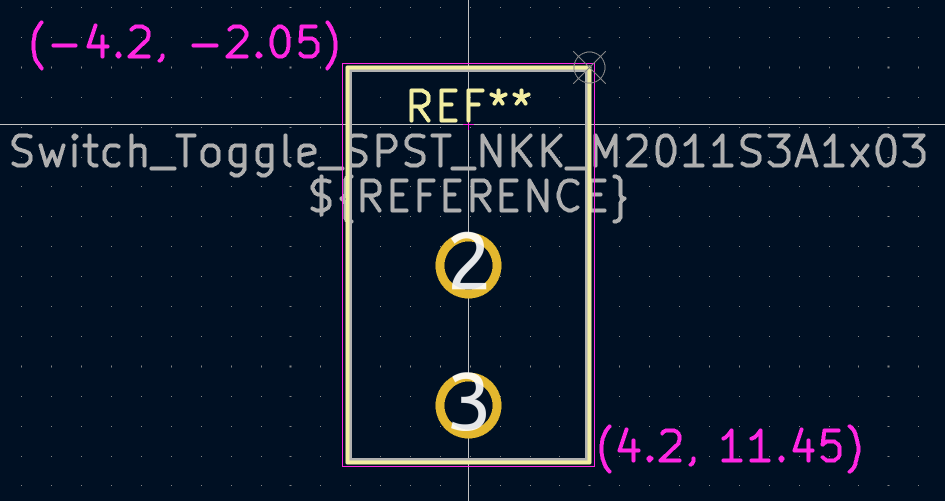
Dopo aver completato i contorni, posizionare il testo come mostrato di seguito. L’impronta è completa.

Convenzioni librerie KiCad
Per mantenere librerie di simboli e impronte di alta qualità, KiCad ha un documento KiCad Library Conventions, che è un set di linee guida per simboli e impronte. Non è necessario seguire queste convenzioni per le librerie personali, ma sono un buon punto di partenza. Le impronte e i simboli nella biblioteca ufficiale devono seguire KLC. KLC è usato come base per i simboli e le impronte presenti in questa guida.
Aggiungere interruttori allo schema
Ora che l’impronta è completa, il simbolo dell’interruttore può essere modificato in modo che per impostazione predefinita venga utilizzato l’impronta corrispondente.
Tornare all’editor dei simboli e aprire il simbolo dell’interruttore. Modificare le proprietà del simbolo. Fare clic nel campo Impronta, poi fare clic sull’icona a forma di libro della libreria  che appare. Sfogliare la libreria delle impronte del progetto e fare doppio clic sull’impronta dell’interruttore. Salvare il simbolo.
che appare. Sfogliare la libreria delle impronte del progetto e fare doppio clic sull’impronta dell’interruttore. Salvare il simbolo.
Ora l’impronta dell’interruttore è assegnata a questo simbolo per impostazione predefinita; non è necessario selezionarla manualmente ogni volta che il simbolo viene aggiunto a uno schema.

Aprire lo schema, aggiungere un nuovo simbolo e selezionare il nuovo simbolo dell’interruttore. Allacciarlo per connettere o sconnettere il LED alla batteria.
Non è necessario scegliere manualmente un’impronta per l’interruttore, perché il simbolo dell’interruttore specifica già un’impronta. Eseguire l’ERC per assicurarsi che lo schema modificato non violi alcuna regola elettrica.

Aggiungere l’interruttore alla scheda
Assicurarsi di aver salvato lo schema, poi aprire l’editor scheda per aggiungere il simbolo al progetto. Aggiornare il circuito stampato con le modifiche allo schema usando Strumenti → Aggiorna C.S. dallo schema… e posizionare l’impronta dell’interruttore sulla scheda come mostrato. Se necessario, ridimensionare il bordo della scheda e la zona rame (la zona rame non verrà svuotata se ridimensionata, ma è possibile riempirla nuovamente se necessario con B).
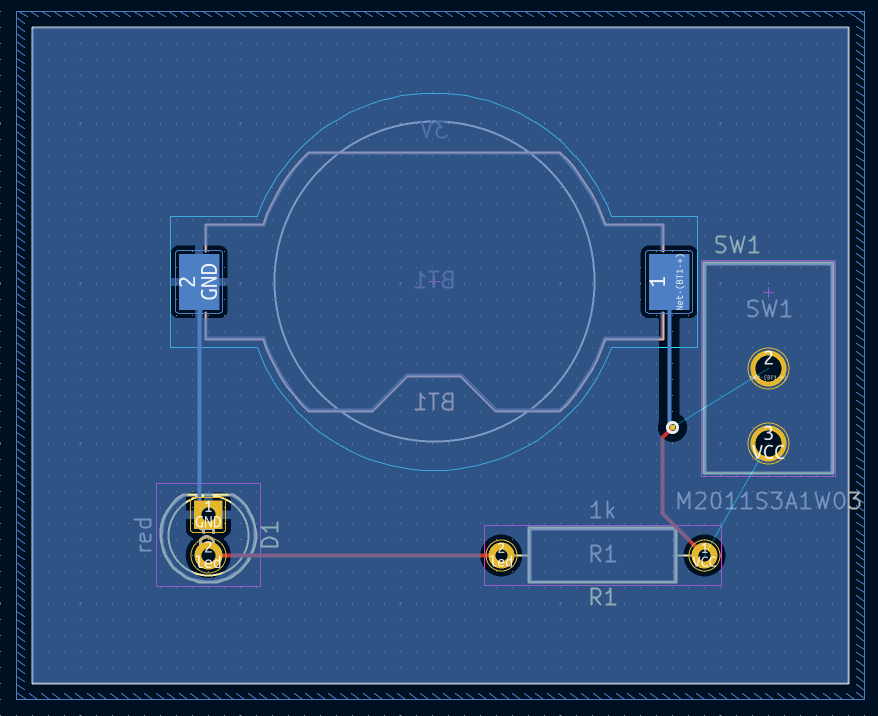
La ratsnest mostra le nuove connessioni da sbrogliare. Inoltre, la connessione tra la batteria e la resistenza deve essere eliminata.
Per primo, eliminare le piste non necessarie. Selezionare una delle piste tra la batteria e la resistenza, non importa quale. Premere U più volte per espandere la selezione e includere tutti i segmenti tra la batteria e la resistenza. Premere Canc per rimuovere la connessione.
Sbrogliare le nuove piste tra la batteria e l’interruttore e tra l’interruttore e la resistenza. Premere B per riempire nuovamente le zone.
Infine, rieseguire un test DRC per assicurarsi che la scheda modificata non violi alcuna regola di progettazione.

Collegare simboli, impronte, e modelli 3D
Simboli e impronte
Come descritto nella sezione assegnazione dell’impronta, a ogni simbolo nello schema deve essere assegnata una impronta durante il processo di inserimento dello schema. Il nome dell’impronta assegnata a ogni simbolo viene memorizzato nel campo Impronta delle proprietà del simbolo.

I simboli possono specificare un’impronta preselezionata. Le impronte non devono necessariamente essere assegnate manualmente a tali simboli, poiché un’impronta era già stata scelta durante la creazione del simbolo. Gli utenti possono sovrascrivere l’impronta preselezionata durante il processo di assegnazione dell’impronta come di consueto. Definire un’impronta predefinita è una buona idea per i simboli a cui solitamente o quasi sempre verrà assegnata la stessa impronta, ad esempio un componente che è disponibile solo per un tipo specifico di package. L’impronta dell’interruttore predefinita era stata impostata come predefinita per il suo simbolo corrispondente.
I simboli possono anche specificare filtri impronte, che possono essere utilizzati per nascondere le impronte incompatibili con il simbolo. Ad esempio, il simbolo 74HC00 ha filtri impronte che determinano la visualizzazione solo di impronte DIP e SO14 applicabili nello strumento di assegnamento impronte.

I requisiti KLC per filtri impronte contengono alcuni suggerimenti utili per creare dei filtri impronte efficaci.
Impronte e modelli 3D
I modelli 3D per i componenti vengono archiviati in file separati. I nomi file per i modelli 3D dei componenti vengono salvati nell’impronta. È possibile aggiungere un numero qualsiasi di modelli 3D ad ogni impronta. I nomi file dei modelli 3D, insieme a scala del modello, rotazione, scostamento e opacità, sono impostati nella scheda Modelli 3D delle Proprietà dell’impronta.
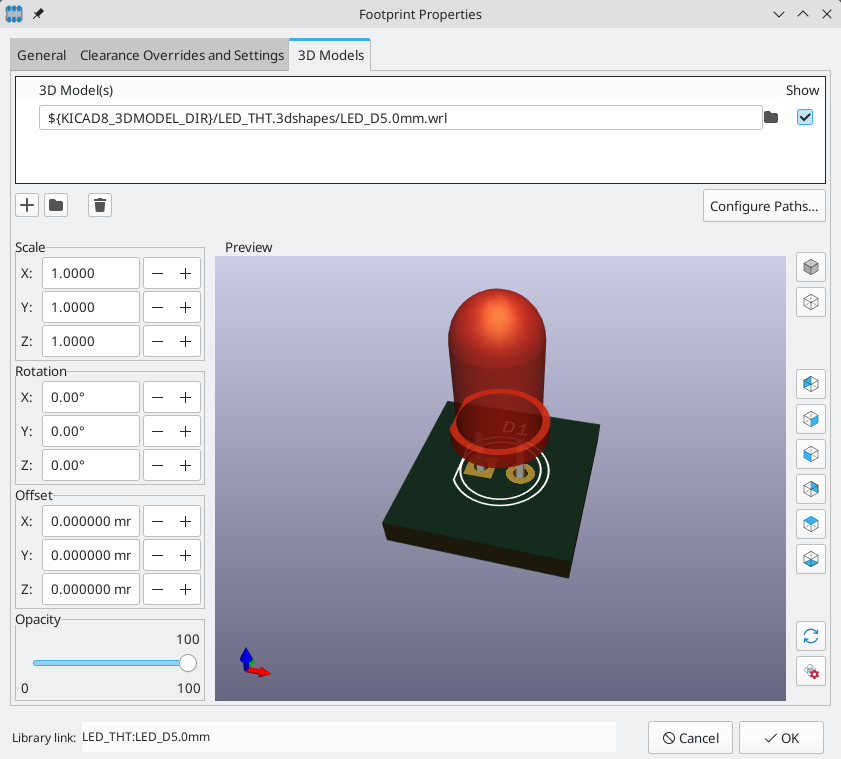
Sono supportati sia il formato di modelli 3D STEP (.step) che VRML (.wrl). I file STEP sono utili quando è richiesta precisione dimensionale, mentre i file VRML possono essere utilizzati per i rendering visivamente più accattivanti. Molte impronte nella libreria di KiCad hanno modelli 3D associati; questi modelli sono forniti sia in formato VRML che STEP. Solo uno dei due modelli deve essere elencato nell’impronta (in genere viene fornito il nome file VRML). KiCad può sostituire automaticamente la versione STEP quando esporta un modello 3D della scheda per l’utilizzo nei CAD meccanici.
| Non tutte le impronte nella libreria di KiCad sono fornite di modelli 3D, ma tutti le impronte elencano un nome file di modello 3D anche se il modello 3D non esiste. Questo perché i modelli 3D potrebbero essere aggiunti in un secondo momento senza dover modificare l’impronta. |
FreeCAD insieme a StepUp Workbench sono utili per creare modelli 3D di componenti; sono usati per molti dei modelli nella libreria di KiCad. StepUp è usato per generare file STEP e VRML con posizionamento, ridimensionamento e rotazione corretti.
Come continuare
Ulteriori risorse di apprendimento
Per maggiori informazioni su come utilizzare KiCad, consultare il manuale.
Altre risorse includono il forum ufficiale degli utenti di KiCad, le chat Discord o IRC e ulteriori risorse di apprendimento dalla comunità KiCad.
Per scoprire di più sulle possibilità offerte da KiCad, visitare la sezione Made With KiCad del sito web oppure aprire i progetti demo inclusi in KiCad (File → Apri progetto demo…).
Aiutaci a migliorare KiCad
Per segnalare un difetto o richiedere una funzionalità, usare Aiuto → Segnala un difetto o aprire una segnalazione su Gitlab.
Per contribuire allo sviluppo di KiCad, consultare la pagina dei contributi degli sviluppatori. Anche i semplici utenti possono aiutare contribuendo allo sviluppo delle librerie o della documentazione e traduzione. Infine, si consideri il supporto finanziariario per mantenere in modo continuo lo sviluppo di KiCad.